#this plot can feature both external and internal “monsters”
Explore tagged Tumblr posts
Text
amazed at the number of people who say aftg has no plot or tsc has no plot like idk maybe yall are used to plot driven genres like fantasy or mystery where the plot line is at the forefront & the force driving the characters actions rather than vice versa but these books still definitely have plots. the ravens trying to get neil to sign is plot. the foxes training to win championships is plot. Andrew and Neil's romance is plot. the entire thing with the butcher & his posse – plot. Jean joining a new team and learning how to live and thrive and adjust to the world outside the cult he's been trapped in? plot. just because the story/narration is more character driven doesn't mean the plot isn't there.
#aftg#do they still teach the different types of plot in high school language arts courses?#plot number 1: overcoming the monster#sound familiar?#this plot can feature both external and internal “monsters”#the monster in this plot *can* simply be characters trauma or personal issues that they must overcome#in order to thrive/reach their happy ending#anyway#this is bitchy but im tired of people constantly talking down on these books#all for the game#the sunshine court
61 notes
·
View notes
Text
Writing Notes: Story Plot
Plot - is what happens in a story.
Every story is made up of both events and characters.
A story happens because a pattern is interrupted.
If you are writing about a day that is like any other day, it is most likely a routine, not a story.
A Strong Plot
Centered on one moment—an interruption of a pattern, a turning point, or an action—that raises a dramatic question, which must be answered throughout the course of the story. This is also known as plot A.
Every element of the plot—each scene, each line—exists in service of answering that question. There are myriad plot devices that can bolster the main story; these are considered subplots.
7 Types of Plots
The nature of the dramatic question informs the plot and what kind of story it will be. Are the characters threatened by something external or internal? What genre will the story be?
Tragedy
Your main character should undergo a major change of fortune — almost always from good to bad, happy to sad.
Tragic characters have to suffer.
Comedy
Even though your characters have defects, their defects should never wind up being painful or destructive.
Comic characters make it through unscathed.
Hero’s Journey
The hero of a story must undergo two things:
Recognition and reversal of a situation.
Something has to happen from the outside that inspires the hero in a way that he/she didn’t realize before.
Then he has to undertake a quest to solve the situation.
Rags to Riches
Remember Cinderella? The classic fairy tale follows a simple rags-to-riches plot:
the protagonist is downtrodden, impoverished, or otherwise struggling, and through a series of events—either magical, like in Cinderella, or more realistic, like in Great Expectations — achieves success.
This type of plot often features a happy ending.
Rebirth
The rebirth style of plot follows a character’s transformation from bad to good.
The character will frequently have a tragic past that informs their current negative view of life, however, a series of events (usually set in motion by the protagonist or a narrator) will help them see the light.
See: Scrooge in A Christmas Carol, or the Beast in Beauty and the Beast.
Overcoming the Monster
Otherwise known as the good versus evil plot, this type of story features a protagonist (good) fighting an antagonist (evil).
The protagonist can be a singular character or a group united in their mission.
The antagonist is generally a big, bad evil (like Darth Vader in Star Wars) who continuously throws obstacles in the protagonist’s way—until the final battle.
Voyage & Return
This plot is a simple point A to point B and back to point A plot.
The protagonist sets off on a journey, only to return to his or her starting point having gained wisdom and experience (and sometimes treasure too).
Paulo Coelho's The Alchemist is a beloved contemporary illustration of this plot.
How to Outline a Story Plot: Three-Act Structure
Beginning
The beginning of your novel has to accomplish a lot.
It must introduce the hero, the villain, and the world of the story, as well as the story’s dramatic question, and it must do this with enough energy to grab your reader’s interest right away.
A prologue can be useful for seizing the reader’s attention.
Middle
Your job during the middle of the story is to make the hero’s quest as difficult as possible so that at every moment it seems less likely that the hero will triumph.
You must raise the stakes along the way and create obstacles of ever-increasing intensity while keeping your eye firmly fixed on your conclusion.
The different plot points can include the basic plot, plus various subplots.
The main plot of a story always has to build up to the resolution.
End
The end of your story answers the dramatic question, which already has your ending hidden within it.
For example, if your question is:
Will Ahab catch the whale?
Then your story’s finale will be the moment when he does.
Often, tension evaporates in the middle of a novel, so it’s a good idea to write your ending first. It may not be perfect, and you can always change it later, but it’s useful to know the climax to which your characters are headed.
Having that destination will help you stay focused during the “middle muddle.”
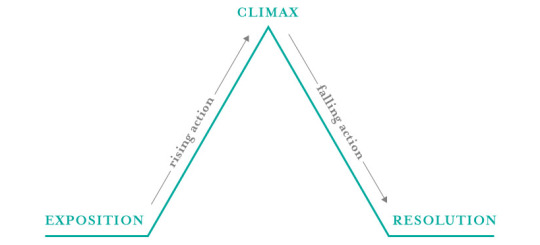
Freytag’s Pyramid
German novelist Gustav Freytag expanded on Aristotle’s concept of plot by adding 2 additional components to the beginning, middle, and end:
Rising action and falling action.
Freytag’s dramatic arc, also known as Freytag’s Pyramid, includes the following:
Exposition. This is the beginning of the story.
Rising action. Once the story has begun, it is important to create tension by raising the stakes. You must raise the stakes along the way and create obstacles of ever-increasing intensity while keeping your eye firmly fixed on your conclusion.
Climax (middle). The pinnacle of your plot.
Falling action. The falling action occurs after the climax but before the end. Falling action frequently depicts the protagonist dealing with the consequences or fallout of the climax. The falling action is when the protagonist ties up loose ends and heads toward the conclusion. It is also referred to as the denouement.
Resolution. This is the end of the story.
Source ⚜ The 3-Act Structure: History & Elements ⚜ A Guide More References: Plot ⚜ Character ⚜ Worldbuilding ⚜ Writing Notes
#plot#on writing#writing tips#writing advice#writeblr#dark academia#spilled ink#writing reference#writing inspiration#creative writing#fiction#writing ideas#literature#writers on tumblr#poets on tumblr#writing prompt#poetry#light academia#writing resources
281 notes
·
View notes
Text
On the corrupted!Steven theory...
So, originally when I mused on this yesterday I was just playing around with random possibilities.
After combing the series for info about corruption, though, I’m mildly spooked at the increased potential for this to... perhaps be a thing? I’m not saying that this is what I for sure believe will happen- to be honest, I’m not even sure Crewniverse would go this direction at all- but just for funsies, let’s see what kind of “evidence” or “foreshadowing” exists that might support this potential story path in the context of canon.
(EDIT: 10/7/19
I honestly no longer think this creature is a worm at all whatsoever, it’s either more akin to a horned caterpillar or potentially has limbs. Either way we can see so little right now that it’s hard to tell. I’m not editing the rest of this post because I want it to exist in its original form- but do keep this in mind reading the rest! XP)
1) The design of this worm creature.
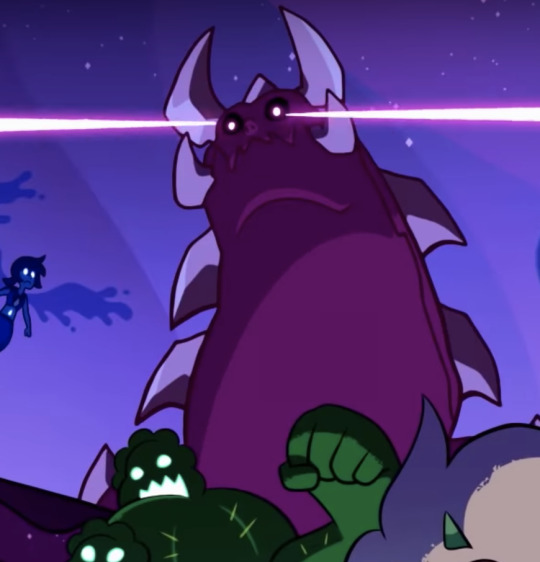
Let’s start simple. Let’s start tangible.
For future reference and simplicity, I will be henceforth be referring to this creature as... “Wormy Boi.”
So, let’s see what we’ve got here. I’m definitely not the first person to point out this fella’s pink nature, and the jarringly human-like nose they’ve got. (Compared to other corruptions, which have had distinctly non-humanoid features.) In the photo above, we also have Wormy Boi sporting glowing pink eyes, which then send out a flare of pink light/energy. So, seemingly a powerful entity.
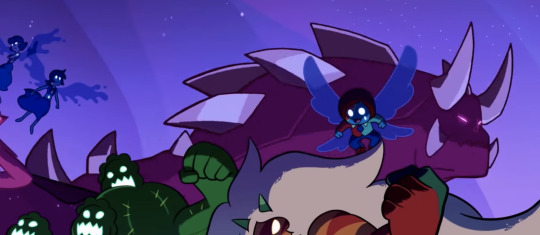
If you watch the short segment before they sit upright, you’ll see that Wormy Boi is super, super big. They’re in the background, but BOY do they loom. The shadows cast upon them especially push that sense of size. They’ve also got a whole bunch of spikes on their back and framing their face.
So, then. What evidence could be made for this being a corrupted!Steven, as opposed to some other run-of-the-mill monster?
Steven Universe Future is a limited series, described as ‘tying up loose ends.” To me, as a viewer, it would make far more sense for the antagonists/conflicts to deal with big concepts that have already been established since there’s such a limited amount of time we have left with this world. Introducing a completely alien species in the last act of the show would feel offbeat from both a writing and a viewing perspective. Corruption- on the other hand- is something we don’t have full answers to yet.
We don’t see any gem, yes- but Steven’s gem is- of course- on his belly. If this theory were to be true, that would translate to the gem being on Wormy Boi’s underside, far out of our sight in this shot, due to how massive they are. As an addition to this, not showing the gem gives an air of mystery to this creature’s true nature- which makes it seem like there’s something surprising to discover here.
A corrupted diamond would surely be MASSIVE. Also, very powerful. The beam of pink light hints at Wormy Boi being quite a powerhouse.
The spikes on Wormy Boi’s back and around their face highly resemble rose thorns. We all know how much the Crewniverse loves their rose symbolism, and design wise, this aspect would make a lot of visual sense for a corrupted Steven. Running off of that:
The face/nose shape and the five horns on this creature’s head give off a very Steven-like silhouette.
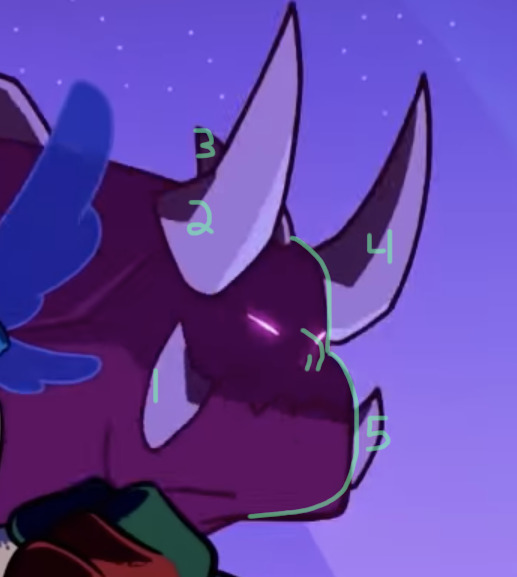
The nose, of course. The face has a very Steven-like shape to it, overall- although noticeably more angular and sharp. The mouth is reminiscent of the Watermelon Stevens’ mouths. And as for the horns, there’s five of them positioned equidistant around their face, just as Steven’s hair is always formed from five lil’ bumps at the same positions.
Okay, moving on.
(Read more under the cut!)
2) We do not yet understand the true nature of corruption.
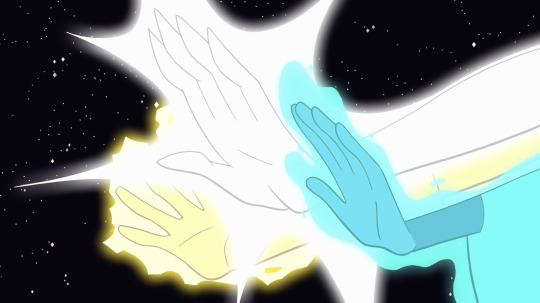
“I guess it’ll take more than a kiss to heal damage from the Diamonds…” -Pearl, Monster Reunion
Corruption is still- bafflingly- a huge mystery. The Gems we’ve watched the CGs bubble since season one have been healed, yes, but there are still many gaps in our understanding of it. With Steven Universe Future’s promise to address some lingering story threads, it would make sense if corruption was on the plate for further discussion. So, what DO we know?
We know it’s something the Diamonds can do. Interestingly, it doesn’t seem to require all four diamonds. Three of them together were able to cause all the damage to Earth. There’s also no statement made that more than one Diamond is required to cause effects like that.
In Legs From Here to Homeworld, Blue and Yellow Diamond weren’t actually aware the corruption was something they were capable of producing. They seemed to assume they obliterated the Gems on Earth. Corruption is then, even a mystery to them. That’s... odd, isn’t it?
Pearl states that it’s “something nearly impossible to describe.” Garnet goes further to say... “It’s sorta like... if MC Bear-Bear didn’t tear the fabric of his arm, but the fabric of his mind.”
"A sound… A song?” There’s a lot of association between corruption and music.
It causes Gems to lose touch with their usual forms, instead warping into a more outwardly "monstrous” version of themselves that appear to be “just a bundle of fight-or-flight reflexes and survival instincts.” As seen by Centipeetle in Monster Buddy and Monster Reunion, it appears as if corrupted Gems try to regenerate with their original forms if unbubbled, but are simply not in a state where they can maintain that.
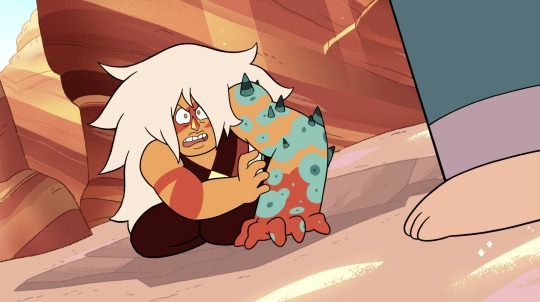
As seen with Jasper in Earthlings, extreme emotional distress very much seems to speed up corruption’s effects. This is less of a stated fact and more of my read on that episode, but I believe it to be an important tidbit, especially since Garnet states that corruption’s damage is mental rather than physical, at least at its core. This can also be seen in Monster Reunion with how Centipeetle’s partial healing backfires when she remembers the trauma of being corrupted and reacts strongly.
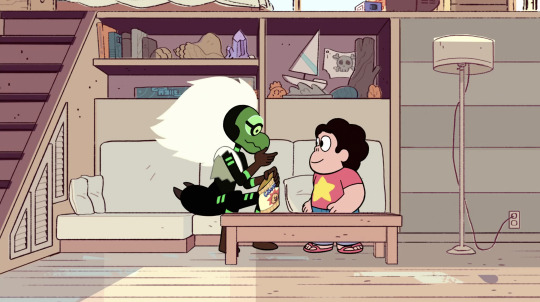
Now, when it comes to healing corruption, Steven tries to heal Centipeetle himself, and does make some nice progress... helping her regain a hold on herself as he treats her with love and compassion and understanding... but it’s ultimately not a healing that can occur in isolation, helping her on his own. She needs more support before she can heal from this corruption to a state where she can truly be herself again.
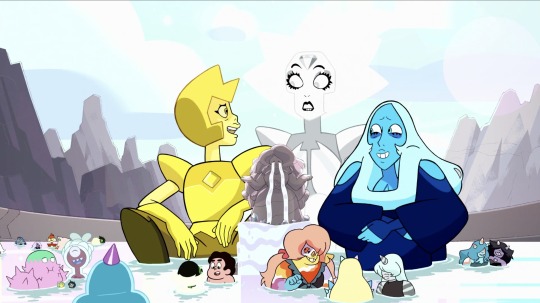
And that eventually comes in the form of the other Diamonds. So, all four diamonds can help relieve the corruption if they help these Gems all together.
3) How could this theory potentially fit into the story anyways, you nutter?
Well, here’s the part of this post where I make some broad conjectures. I honestly am shooting fish into a barrel here because again- we know barely anything about how corruption actually happened initially, and my thoughts are very jumbled. Please forgive me.
"I don’t really know how the corruption works. It’s like they’re sick. They don’t remember who they used to be.” -Steven, Gem Hunt
So, corruption seems to be a mental ailment of Gemkind, turned manifest. It also seems to have a deep connection to a Gem’s emotions, with Centipeetle growing smaller and slightly calmer upon feeling more secure in Steven’s presence, and corruption speeding up as Jasper grew more and more emotionally overwrought and self-deriding about herself.
When it comes to the Diamonds and how they perhaps caused it originally- without fully realizing- we know that at least Blue and White have abilities focused on causing others to act in certain ways. Blue has sway over one’s emotions, and White has a knack for forcing her thoughts and self upon others. (I’m not sure how Yellow’s ability would play in here.) Mayhaps, mixed with their grief and guilt and anger, their power simply pressed all of that hurt emotion onto all the Gems on Earth in one whole fail swoop...? Tearing their minds in the process of it all?
The question I still have, though- is whether a single diamond could produce effects like this. And whether a diamond could turn that ability on themself.
Could Steven accidentally corrupt himself? Why might that happen?
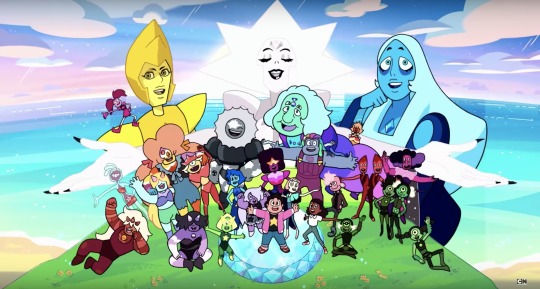
Well, let’s look at our boy here.
He’s got a wide circle of support at this time in canon, but notably, he’s notorious for bottling up his emotion and not letting others in to help him- instead dropping everything to help them with their problems. Just to name a few examples (a few):
The Test. He feels betrayed and hurt at the Gems for a moment about the way they’re babying him with the rigged test, but instead of admitting the hurt he feels about the scenario, bottles that up to help them feel more like good guardians.
Joy Ride. He opens up to the Cool Kids about deep, incredibly troubling stuff that’s long been on his mind, but he’s never once talked about it with his family.
Mindful Education. The perils of bottling one’s emotions is literally the whole plot of the episode. The kid has a full out sobbing breakdown while he’s plunging to his death. Connie gets through to him a little here, but later episodes show that the resolution we see here is merely the tip of the iceberg when it comes to Steven’s internal issues.
Storm in the Room. Externally, Steven tries so hard to put on a guise of content and positivity, but once alone in Rose’s room feels safe enough to let the full brunt of his emotional trauma come out in an almost explosive manner. Geeze, get this kid some hugs.
Gemcation. Steven actually fails bitterly on putting on his customary smile in this episode, simply because the weight of his problems have become such an impossible burden to him. When the other Gems are trying to help him open up, he isn’t immediately responsive to their efforts.
What’s Your Problem? Amethyst spends the whole episode trying to cheer Steven up and find out how he’s doing, and instead Steven downplays his own feelings on the matter and ends up helping her sort out her own emotional issues.

So to sum: Many an Emotional Issue, a chronic tendency to avoid outwardly addressing said issues in favor of helping everyone else instead... and to avoid accepting other people’s help.
Even if he’s surrounded by all these people who love him, the fact of the matter is that Steven still feels as if he has to face his own inner demons alone.
Now, let’s look at the lil’ teasing synopsis that was given for Steven Universe Future:
“After saving the universe, Steven is still at it, tying up every loose end. But as he runs out of other people’s problems to solve, he’ll finally have to face his own.”
Blatantly sounds like we’re gonna finally get some addressing of Steven’s emotional state, now doesn’t it?
4) A concept on what could, theoretically happen
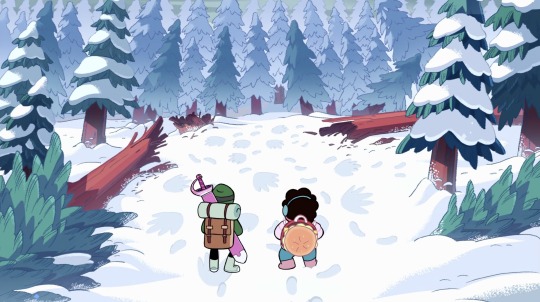
“Maybe… it IS a guy in a monster costume. I don’t mean literally, silly! What I mean is... there might be a conscious Gem still inside there, somewhere. What if the monster is turning back and forth into its original form? If it is, it might not be as corrupted as we think! There might still be a chance to save it!” -Steven, Gem Hunt
Suppose Steven- by some as-of-yet unknown means- ends up accidentally corrupting himself. His sorry emotional state only further amplifies the effects of this corruption, and makes it really hard to retain control. Wormy Boi as a form could be like... all his inner demons made manifest, a metaphoric mirror into his current mental state. But- as he is half-human- he’s not entirely unaware of what’s happening. Perhaps... as the quote above could be sneaky foreshadowing for... how he’s turning back and forth between this corrupted form and his normal form.
He likely wouldn’t want everyone to see him like this, doesn’t want everyone to visibly know the sheer depth of how much he’s hurting. But just like the corrupted Gems were only able to be helped in community, with the support of the CGs and the Diamonds in preparing the fountain, Steven can’t fix this on his own.
He can no longer face the dark alone.
At some point, everyone has to take a brave step. Reach out. Accept help.
Steven’s helped so many people, and surely he deserves that same love and care in return, too.

And perhaps, when he’s eventually healed from this- and has gotten the opportunity to be open with his family and friends about the hurt he’s facing- he’ll be left with “corruption scars” as well. I think it’s an important thing to address, that no one goes through experiences like these without lingering effects. Stuff stays with you. Healing is not always linear. But life is a continuous journey, and with the support of people who love you surrounding, you too can make a change... can continue to live to the fullest at every moment possible.
I think the above would be a lovely moral for Steven Universe to tackle in its last run of episodes, no matter how they approach it- daft corruption theory or not.
Now, in the end- a reiteration. This is just a wild theory. I’m not trying to be any authoritative voice saying that this is for sure what will happen, because in reality I have no idea what Crewniverse is cooking. However, I do think it’s fun speculation, and I am kinda spooked at how well things fit.
Whatever happens, I’m sure it will make me weep like a baby, though. Hoh boy. Grant me sanity in these coming months as we wait for answers.
#su#steven universe#su future#steven universe future#su theory#corrupted steven theory#my post stuff#long post#the mighty 500#1K#2K#3K#4K#5K
8K notes
·
View notes
Note
Will and El are technically the same person? Along with Hopper? Did I get that right? This is so confusing.
Hello there! Thanks for Asking.
My current hypothesis regarding what might be happening in Stranger Things is that we are following a story about a DID System and that many characters in the series are perhaps alters and hosts (separate states of consciousness and identity within one human mind) dealing with trauma memories and seeking to learn to work together to protect one another and the DID System as a whole.
The short answer to your question is: only if you perceive of alters (different states of consciousness that have their own individual sense of identity and self) that are sharing the same human mind as being “the same person.” Generally those with DID will refer to themselves as being “multiple,” as being hosts in a DID System, as being alters or as having alters etc. Each alter will have their own distinct memories and life experiences that they’ve lived (both in the external world and the internal worlds that might exist in their mind) and that are part of who they know themselves to be just as individuals with a single state of consciousness have built their sense of identity over many years of lived experiences.
kaypeace21 and I might be (?) the only two bloggers on Tumblr analyzing the concept that El, Will, and Hopper (and potentially many other characters) are all sharing the same mind and are part of a DID System (but if there's anyone else I'd enjoy following their blog!)
@kaypeace21‘s hypothesis is that the writers of Stranger Things are telling a fictional sci fi / fantasy story that, like in X-Men or Akira (etc.), involves characters with superpowers and psychic abilities. Her theory is that because Will has both dissociative identity disorder and psychic / supernatural abilities that he has unintentionally and subconsciously brought his alters, his trauma memories, and his internal worlds to life and they’ve escaped his mind and are now in the real world and in Hawkins.
Although I do consider @kaypeace21′s hypothesis that everything has been brought to life and has emerged from Will’s mind into Hawkins by supernatural means (like David Haller’s / Legion’s alters do in X-Men) to be a very well-argued theory and analysis of what might be happening in Stranger Things, I have recently pushed my own hypothesis regarding what is happening in the story towards questioning whether the supernatural events and superpowers of Stranger Things might exist exclusively within internal worlds in our characters’ subconscious. I’m unsure of how much of their “real” physical world we have seen yet in the series if I follow this train of thought, and how much of it is memories that are symbolically playing out in an internal world of their mind. In short: I think there might be a certain level of consciousness and wakefulness at which they’re all still in the same body that we have perhaps not fully seen or realized yet because of the creative way that the series is telling the story (although this might have been imaginatively represented in season 2 when Will and/or the Mindflayer are conscious/unconscious at the Lab with Dr. Owens.)
Perhaps El and Will only appear separately and can only interact with one another in internal worlds, while co-conscious, or within liminal spaces between wakefulness and unconsciousness because Hawkins is not always their “real” world but is an internal world in their shared brain. Maybe Hawkins is similar to the Upside Down, which I also believe is a mental construct, but more comfortable since it’s meant to be a home for alters to live rather than a place that trauma has been hidden away. I think that El is a gatekeeper in the DID System. And I currently hypothesize that Hopper is also possible part of that same DID System and that Hopper is a protector and potentially also a gatekeeper. (Hopefully I will find the time to write a new post about Hopper sometime in the near future.)
The questions that I keep asking myself are: what if some moments in the story are not actually taking place in the ‘real world’ even within the Stranger Things universe? What if many moments in the series so far have been fantastical because they were moments in characters’ lives that were re-imagined by their subconscious mind in order to cope with trauma? Not hallucinations (because as Hopper says “these aren’t nightmares, it’s happening”) but imaginative re-workings of "what happened” in their life that are easier for their mind to process. PTSD and internal flashbacks and also reworked memories that manifest themselves more symbolically and metaphorically within fantastical internal worlds.
Many movies on the Stranger Things 4 Video Store Friday movie list encourage me to continue questioning the boundaries between Stranger Things characters’ physical lives and what they might be experiencing as flashbacks or as memories within internal worlds and different states of consciousness. A few films on the list which inspire me to question what might be going on in Hawkins and what Hopper, El, and Will (and many other characters) might be dealing with include Altered States, The Fisher King, The Matrix, Inside Out, Inception, The Truman Show, What Dreams May Come, Drop Dead Fred, The Cell, The Neverending Story, and many others.
The first season of Stranger Things had a lot of artistic and thematic strength in its mystery and layers of ambiguity, but I suspect that once Stranger Things was renewed and they knew that they could have multiple seasons they began planning how to reveal what’s going on behind the curtain of mystery in a meaningful way by the end of the story.
The big question is: what has been happening in these characters’ lives? Am I “overthinking things” as some of my friends have told me? Is it really “not that deep?”
Here are a few blogposts that I have written on this topic in which I explore some of my thoughts regarding what might be happening in the series if Stranger Things is about a DID System, internal worlds, and alters dealing with trauma:
🧠 What is going on with the eerie parallels between Will and El?
👀 My response to an Ask: "Do you think there’s any relation or symbolism between a Brenner and Lonnie other than being shitty/abusive father figures?"
🦸♀️ My response to an Ask: "What are the source of their powers?" in which I share my "first layer" and "second layer" meta theories/thoughts (re: The DID Theory) + a brief follow-up Ask regarding the concept that El's powers might only exist in internal worlds if she is a fictive alter
🏞 My response to an Ask: What do you think is going to happen with the Upside Down especially if Will and El's connection grows?
In this post I briefly address how El, if she were a teenage girl alter that exists in an internal world of the mind but who is sometimes conscious in Will’s body in the “real world”, would have experiences comparable to those of a trans girl
Truthfully: I am at the point that I speculate that nearly all of the characters exist as alters either exclusively or are introjects which are alters based on people that the DID System knows that exist in the external world. But I realize that would be quite the plot twist and might push the question of “what is real?” farther than some fans might be willing to go.
I recognize that this is a lot of information and theoretical content and blog links to provide to you in response to your general Ask but I wanted to offer you reference points and direct you to other blog posts regarding this theory in case you wanted to learn more about the evidence and analyses that led me and a few other bloggers to these hypotheses. If you have any other questions regarding my theories regarding what might be happening in Stranger Things (whether that’s this topic or others) please don’t hesitate to send me another Ask or to DM me directly. I always enjoy talking about ideas with other fans. :)
If this concept interests you I know that kaypeace21 would greatly enjoy sharing her own theories with you and answering any questions you have. I highly recommend that you visit her blog, read her posts, and message her if this topic interests you because my thoughts are often very different from hers and you might enjoy reading both of our blogs for two different theories based around the same hypothesis: that Will has dissociative identity disorder and that this influences all events in the series. If you are interested in reading about her current analysis that hypothesizes that superpowers are real in Stranger Things, that Will has dissociative identity disorder, and that both monsters and some other characters have emerged from Will’s subconsciousness into the “real world” of Hawkins then I recommend reading these two blogposts that she wrote: 🧠 Part 1: Will Created the Mindflayer and Upside-Down Theory + Part 2: Some of your favorite characters are Will’s split personalities (psych/narrative analysis) CW: abuse, sexual assault, psychological trauma (a content warning is also noted before the section in the post itself.)
I do agree with many aspects of kaypeace21′s theories and I think she explains how dissociative identity disorder might influence many events of the story so far in a way that I do find compelling, but the critical difference between our hypotheses is that kaypeace21 currently proposes that Stranger Things features characters with DID that also have superpowers (like David Haller in X-Men) but I currently think that the vast majority of what we have seen on screen in the series so far is “not real” and exists only within characters’ minds and I do not believe that El has any superpowers except when she is within internal worlds. (And that’s a fairly notable difference.) I also don’t think that the Mindflayer exists as a blobby mass of melted people except within internal worlds in their mind. I wonder if the vast majority of season 3 took place entirely in an internal world version of Hawkins and when Will said “what if we locked him out here with us?” to El that he might have been more accurate if he had said “what if we locked him IN here with us?” in very simple terms: I want to know if Will has actually woken up yet from being sedated in season 2 at all, or maybe whether he's sometimes present in the external world but then sometimes switches back to the internal world, etc. (But perhaps the events of season 4 will invalidate this thought of mine. I look forward to seeing what happens!)
Thank you again for your message. I hope my response wasn’t too rambling, that I didn’t repeat myself too much, and that it remained coherent in spite of how late at night I am writing this. I might return and edit this in the morning. (I’m wrapping up this reply at 12:56 AM but I started writing this at 10PM. Time flew by! Time for sleep.) Goodnight :)
#stranger things theory#stranger things theories#the did theory#stranger things is perhaps about a did system + internal worlds alters and trauma#el and will#will and el#and hopper#and many others
15 notes
·
View notes
Text
Systems vs. Individuals in Dark Magical Girl Stories
Who is the primary antagonist of Puella Magi Madoka Magica? The obvious answer is Kyubey, who deceives the protagonists into signing the Faustian contract. Homura's goal is to stop Madoka from becoming a magical girl, which sometimes causes her to fight Kyubey both directly and indirectly. Yet choosing Kyubey as the answer relies on two flawed assumptions:
1. Homura is primarily struggling against Kyubey.
2. Homura is the protagonist of Puella Magi Madoka Magica.
The first assumption is incorrect because, while Homura does on occasion oppose Kyubey, she is far more concerned with removing situations that would prompt Madoka to sign the contract. As such, her conflicts with Mami, Sayaka, and Walpurgisnacht equal or even take precedence over her conflict with Kyubey. Kyubey is impossible to defeat, something Homura recognizes. When she kills one of Kyubey's innumerable bodies, she does so solely to delay.
In the back half of PMMM, Homura enlists Kyoko to help her fight Walpurgisnacht. She stockpiles military-grade weapons and sets traps. She prepares a detailed plan of attack that is almost ridiculous in its specificity. All for the purpose of defeating Walpurgisnacht.
Despite her best schemes, Homura never even gets close to defeating Walpurgisnacht on her own. By the end of Episode 11, after Homura has unleashed enough weaponry to arm a small African nation, Walpurgisnacht laughs it off like Homura hasn't even scratched her. Before Madoka steps in and makes her wish, Homura begins to recognize that defeating Walpurgisnacht is an impossibility.
Why does Homura put this much effort into trying to defeat Walpurgisnacht and not Kyubey?
On the surface, Kyubey is seemingly unkillable. If one body is destroyed, another takes its place. Yet the fact that Kyubey grouses about the destruction of a body being "wasteful" implies he has a finite amount of them. Being charitable to Homura, we can assume that in one or several of her previous timelines she attempted to destroy every Kyubey body and failed. But in all of her previous timelines she has attempted to destroy Walpurgisnacht and failed, so why has she given up on Kyubey but not Walpurgisnacht?
This line of questioning possibly comes across as a plot hole nitpick, the kind common among YouTube video essayists. But my goal isn't to say that the story is stupid for having Homura fight Walpurgisnacht instead of Kyubey. Instead, I want to think about Homura's psychology, and about the differences between bad systems and bad individuals.
Homura's mindset is fixated totally on the individual. In particular, the individual Madoka Kaname. Her goal is, explicitly, unambiguously, to "save Madoka Kaname." The magical girl system disinterests her beyond its corrupting influence on Madoka. Homura never seems to regret becoming a magical girl herself. Even at the end of the story, when she is about to succumb to despair, she does not regret becoming a magical girl, only that she could not save Madoka. Madoka makes a miraculous wish that improves the magical girl system for everyone and Homura is upset because it means Madoka ceases to exist.
Homura cannot operate on the level of the system. It is simply not her concern. As such, she prioritizes the immediate, corporeal threat of Walpurgisnacht over the abstract, systemic threat of Kyubey. Walpurgisnacht is a "thing" that can be fought and, assumedly, killed. Kyubey appears to be a "thing," but is actually an extension of the magical girl system itself and cannot be killed, at least not with a gun.
The problem is that Homura does not realize that Walpurgisnacht is, like Kyubey, also a non-individual. The name "Walpurgisnacht" refers to a gathering of witches and demons. In Goethe's Faust, a story to which PMMM makes frequent explicit reference, Walpurgisnacht features as a Pandaemonium of sorts where innumerable ghoulish figures interact with the protagonist. Writer Gen Urobuchi, in a 2011 interview, described Walpurgisnacht as such:
It has the destructive power to bring about natural disasters powerful enough to blow away an entire town, but originally it was a single witch. It's a witch that has grown from the combination of countless other witches. Walpurgisnacht combines with other witches in the same way two powerful tornadoes are able to combine and become larger. It's essentially a "conglomeration"-type witch. Because it's so powerful, it rarely shows itself.
Much as Kyubey is an amalgam of bodies possessing a singular purpose, Walpurgisnacht is comprised of an amalgam of witches inflicting a singular destruction upon the world. Like Kyubey, the individuality is an illusion, and as such, the individual-focused Homura cannot defeat it by herself, not in any timeline.
That doesn't mean Walpurgisnacht is undefeatable. Indeed, Walpurgisnacht is shown defeated in a previous timeline; but defeated by Madoka and Homura working together, not by Homura alone. Even though at this point in the story Homura is a significantly weaker combatant, and even though Madoka is not shown to be anything more than an average magical girl herself, they somehow accomplished what a Homura possessed of perfect foresight, immaculately armed, and in peak physical condition could not. If read literally, it must be concluded that Madoka is capable of accomplishing something that Homura cannot, regardless of Homura's physical prowess and perfect (time travel-aided) intelligence.
What does Madoka possess that Homura does not?
Why is Madoka the protagonist of Puella Magi Madoka Magica, and not Homura?
The second question may at first seem strange. After all, Madoka serves as the primary point of view character for most of the show, while Homura comes off as aloof and even antagonistic until near the end. Over time, however, it becomes clear that Homura is the one driving the action of the story, while Madoka, although central to Homura's motivations, is often a useless tagalong. Simply being the point of view character doesn't immediately make one the protagonist, as Nick Carraway and Dr. Watson can attest. Madoka's role for most of the story is closer to the damsel in distress than the hero.
And yet, while Homura drives the action and fights Walpurgisnacht and has the goal most central to PMMM's storyline, she is utterly incapable of achieving her goal. She doesn't simply fail, she fails over and over and over again until the prospect of success begins to appear to her as an impossibility and she teeters on the precipice of despair. She fails despite being stronger and faster and more knowledgeable than previous incarnations of her that succeeded with Madoka's help.
Madoka steps into the final episode after an entire story of uselessness, does one thing, and fixes everything.
The reason is because Madoka correctly identifies the true antagonist of PMMM. Not Kyubey, not Walpurgisnacht. Not an individual, not a monster to fight, not something that can be shot and killed. The magical girl system itself. Her ability to identify this antagonist is what sets her apart from Homura. If Homura is individual-minded, Madoka is universal-minded. She abhors the suffering of all magical girls. She is kind and compassionate to everyone. This difference is what prompts Homura's one-sided obsession with Madoka to begin with. Homura interpreted Madoka's universal kindness toward everyone as an individual kindness toward Homura in particular. It's this difference that sets the stage for the events that transpire in Rebellion.
(It's important not to conflate this distinction between individual and universal with the distinction between selfish and selfless. Of the characters in PMMM, only Mami makes a truly selfish wish. Sayaka, Kyoko, and Homura make wishes that directly help someone other than themselves. Well, sort of—Homura doesn't wish for Madoka's safety, she wishes specifically for "the power to save Madoka," which indicates a kind of selfish hero complex. Likewise, it's implied that despite the ostensible selfishness of Sayaka and Kyoko's wishes, they made them for selfish reasons, so perhaps the statement is indeed that a selflessness focused on the individual is actually disguised selfishness.)
So, how do you fight a system? As Madoka states explicitly at the beginning of Episode 12, she would not have been able to make her wish if not for Homura's constant struggling. This statement is supported by the literal explanation Kyubey provides for Madoka's immense power, that being that Homura's innumerable repetitions of the timeline have maximized Madoka's "karmic potential." The show's literal answer is obviously fantastical. But the metaphorical implication seems to be that the suffering of individuals, once it reaches a certain magnitude, is capable of prompting universal change. This statement is not particularly controversial if looked at in a historical context; almost every improvement humankind has achieved, political or technological, occurred after humans suffered a long time without it. PMMM ends with a statement of hope: Keep hoping, and eventually your suffering will come to an end. You yourself may be powerless to change the world, but that doesn't make your misery meaningless.
Regardless of its truth, it's a platitudinous statement, akin to "Never give up!" I don't think it's valuable to take that final statement of hope as PMMM's ultimate theme or moral, despite its placement Aesop-like at the show's conclusion. It's a theme one might find in any more traditional magical girl show or even any children's show in general, and it's divorced from the show's many emotional and narrative complexities. What is more valuable is how the show arrives at that conclusion. After all, as I've heard detractors state, Madoka could have technically resolved the entire story as early as Episode 2 by making the same wish as she eventually did. Something, not external but internal, prevents Madoka from doing that until the end of the story.
If Madoka is taken as the protagonist of Puella Magi Madoka Magica, despite role for most of it as a passive, helpless observer, then it's imperative to view the story not as a traditional struggle against a "thing" that can be destroyed (the way Homura views it) but as a struggle for understanding. Madoka requires a certain amount of knowledge, lacking at the show's onset, in order to make the wish she always could have made, the wish she failed to make in countless failed timelines. That knowledge is the answer to the question posed at the beginning of this essay: Who is the antagonist? Who must be defeated?
The answer, broadly, is not an individual, but the system.
I could go more into why she specifically targets the part of the system (the concept of witches) that she does, or why she doesn't eliminate the system entirely. But for now, I want to expand this discussion to another dark magical girl story, Magical Girl Raising Project.
Magical Girl Raising Project is a series of light novels, the first of which was published in 2012, one year after PMMM was released. As of the time of writing, the series has seven distinct arcs, with each arc being a mostly self-contained story (although some characters and plot elements appear in multiple arcs). The first arc was adapted into an anime in 2016. It follows sixteen people who, after a popular mobile game turns them into magical girls, are forced to fight to the death by the game's twisted administrators.
Many dark magical girl shows that came out in the wake of PMMM have been derided as imitators, but while it's possible that these shows would not have been greenlit if not for PMMM's success, narratively most of these shows are quite different outside of superficial similarities. MGRP, for instance, is much closer to Battle Royale or Hunger Games in plot progression than it is to PMMM. However, one way in which MGRP is similar to PMMM, beyond simply featuring magical girls in an unexpectedly violent situation, is the thematic emphasis on systemic change versus defeating bad individuals.
At the beginning of MGRP's first arc, the game's administrators, represented by the mascot character Fav, present themselves as legitimate officials of the "Magical Kingdom" where all magical power originates. The battle royale is justified to its participants as a natural and necessary component of the magical system—the specific excuse being that having too many magical girls drains too much mana, so the number of magical girls must be cut to save energy. Like PMMM, the cruelties that the characters experience are excused as necessary for the benefit of the system. As such, while many of the battle royale's participants are displeased by the situation, few attempt to fight against the system itself and most focus on the immediate threat of their fellow participants.
Where MGRP diverges from PMMM is that this system is eventually revealed as a lie. Fav and his partner Cranberry are indeed representatives of the Magical Kingdom, but the mana problem is a complete fabrication and magical girls can be turned back into normal humans without killing them. In truth, the system is entirely benign, with its only stated goal being to create magical girls who can help humans, and there are no actual systemic drawbacks to being a magical girl. Fav and Cranberry have manufactured the battle royale for their own sociopathic purposes, and the Magical Kingdom is ignorant of their actions. In short, they're outlaws. Once they are both killed by the end of the first arc, the battle royale ends and the survivors live on.
Like PMMM, the initial difficulty the characters have in answering the question "who is the antagonist" prolongs a story that could have ended very early into a bloodbath. Had the battle royale participants known that their true enemies were Fav and Cranberry, they might have worked together to defeat them with relatively little issue. It is the seemingly hopeless systemic explanation for their woes that causes most of them to shut up and do what is expected of them.
Even though the situations are reversed, with a systemic threat concealed by individual threats in PMMM and an individual threat concealed by a systemic threat in MGRP, the psychology of the characters remains consistent between both works. If that was where MGRP ended, then on the whole it would be a fun play on post-PMMM audience expectations without betraying many of the fundamental concepts that underlie PMMM. But MGRP continues, and in its continuations develops a much larger amount of complexity and nuance (not necessarily to be confused with "quality") over this basic dichotomy of antagonistic individuals and antagonistic systems. As I mentioned previously, PMMM's ultimate moral is somewhat platitudinous: Never give up! Homura's individual-minded approach to problem-solving is depicted as fundamentally ineffectual, and her constant failures are only valuable insofar as they inspire Madoka to action. The narrative's focus is on the discovery of the true antagonist, and the actual resolution to the conflict is immediate and abrupt, nearly to deus ex machina levels.
This simplistic resolution is possibly a byproduct of several restraints that, in most other cases, allow for PMMM's phenomenal technical quality. By that I mean, PMMM is a highly simplified story. It has a limited cast of characters, a limited runtime, and a limited narrative arc that strips out almost anything unnecessary in favor of presenting a singular storyline. Its characters are stark, almost archetypal, with few character traits that do not directly feed into their role in the story. It lacks filler and its pacing is extremely even, with a significant plot development occurring every two to three episodes. From a technical standpoint, these are all massive advantages in telling a cohesive, well-designed story, and the popular reaction to PMMM has been overwhelmingly positive despite its niche subject matter and blunt brutality. Indeed, when most people compare PMMM to other dark magical girl stories, the thesis often boils down to "Here is why PMMM is good and this story, with fundamentally similar subject matter, is bad."
But while the limited narrative elements allow for consistent technical excellence, they also limit the narrative's ability to tackle complex subject matter, such as the reformation of necessary but cruel systems for the betterment of all individuals. How do you fight a system? PMMM doesn't have narrative space to delve into that question the way it can its fundamental question of "How do you recognize the true antagonist?" Homura suffers, Madoka learns from her suffering, and then Madoka makes a wish and everything gets better. Never give up! That isn't to denigrate PMMM, which I consider to be the best anime that I've seen. It's simply recognizing that PMMM does not and cannot do everything. Its resolution isn't even bad, per se; on the contrary, it is incredibly cathartic and satisfying. What is important about Madoka's wish is that she recognizes what must be done, not the way that she achieves it. That is why I describe PMMM as a story about Madoka gaining knowledge, not a story about Homura fighting to save Madoka.
MGRP, by contrast, is not a masterpiece on a technical level. Over seven arcs it accumulates a cast of over one hundred named characters, many of whom are completely pointless and die without purpose. Its storylines promulgate and do not always add to the overarching whole. It can lurch between a breakneck pace and long periods where little happens. But this technical sloppiness allows for a much broader, more complex storyline, and through this complexity MGRP is able to accomplish things that PMMM cannot.
As MGRP continues past its initial, death-game-style arcs, it develops into an overarching narrative about an ineffectual, bureaucratic government and various attempts to improve it. The Magical Kingdom, while benign in its stated goals, is nonetheless painted as incompetent at best and corrupted by petty infighting at worst, which allows bad individuals such as Fav and Cranberry to take advantage of it and get away with various misdeeds. The question of "who is the antagonist?" or "what should we be fighting?" becomes again muddied. Should the emphasis be on defeating all the bad individuals, or should it be on reforming the ineffectual system to remove the influence those individuals have? MGRP refrains from answering this question definitively one way or another, a restraint aided by its lack of a single central protagonist. While there are prominent characters who recur from arc to arc, none is present in every arc, and even in arcs where they do appear they are not always in a central role. As such, no one character's goals are aligned with the goals of the story itself.
The most obvious answer of the question "who is the protagonist of MGRP?" would be Snow White, one of the survivors of the first arc who also has the highest number of appearances of any character across the series. The notion of Snow White as protagonist is aided by her moral purity; her goal is consistently to help people and defeat villains, and although she is technically a vigilante insomuch as she operates outside the Magical Kingdom's official law enforcement system, she never wavers in her fundamental moral values when achieving her goals. Regardless of whether she is the protagonist, she is unquestionably a "hero."
However, Snow White is, like Homura, consistently limited in what she is actually able to achieve. The moment she becomes a magical girl, she is described as being incapable of larger-scale activities:
That day marked Snow White's debut. Every night she'd sneak out her window to look for people to help: a middle schooler who'd lost her house key, a university student who'd had their car stolen, and a businessman under pressure for money, to name a few. There were also many troubles she couldn't do anything about, like concealing adultery, a boy unsure of whether or not to confess to the girl he had a crush on, or a retiree desperate for their pension.
Of the three troubles listed that Snow White can't help, the last, about the pension, sticks out to me. The pension, of course, is a problem that cannot be solved on the individual level, and would require some kind of systemic change. Snow White's limitations are delved into later by another magical girl, Ripple:
Sightings of the white magical girl were leaps and bounds ahead of sightings of the others. She wasn't even doing anything spectacular. Her assistance came in small, everyday actions like picking up dropped change, ferrying forgotten lunches, and reminding people to zip up their flies. Was helping with mundane difficulties a magical girl's true purpose? Or was she simply not capable of undertaking greater issues? [...] It wasn't that Ripple didn't want to serve the community, but she was too embarrassed to say otherwise. However, maybe boldly declaring "I want to help others!" and actually doing so was the correct way to be a magical girl, she mused.
This quote is one of the first instances in MGRP of a character wondering what the "correct way to be a magical girl" is, and this question will eventually become core to the series as a whole, with competing ideological notions leading to much of the conflict. For many, Snow White is the "ideal magical girl," morally pure and always performing selfless deeds. Even when she turns from random acts of kindness to tracking down and arresting criminal magical girls, this sense of moral purity remains with her. Yet Snow White is fundamentally incapable of fostering lasting change.
The biggest example of this inability comes in the fourth arc, in which Snow White squares off against a high-ranking but corrupt Magical Kingdom official named Grim Heart, who is attempting to cover up and profit off of illegal experimentation to create stronger magical girls. Grim Heart is not only the leader of one of the Magical Kingdom's three factions (basically, political parties), but she is also a quasi-theocratic figure said to be an incarnation of an ancient deity. Because Grim Heart is an individual, Snow White is capable of fighting and ultimately defeating her. Her criminal actions are exposed and brought to an end. Yet the removal of Grim Heart does not fundamentally improve the government as a whole in any meaningful way. Grim Heart is scapegoated by her faction and epsteined while under arrest. The faction continues its shady activities under new leadership and harangues Snow White and others as early as the very next arc.
Never, not once, does Snow White accomplish any lasting change in the Magical Kingdom. She dispatches individual villains, but that does not resolve the core problems that face her world. She is positioned in contrast to magical girls whose goals are, explicitly, to reform the Magical Kingdom itself. These characters lack Snow White's moral purity, and even the most heroic of them are willing to murder innocent people under an "ends justify the means" philosophy. Again, MGRP inverts what was established in PMMM; rather than the morally pure character being the one who attempts to correct the system and the morally ambiguous character being the one consumed by individual conflicts, the situation is flipped. Snow White is pure but ineffectual; other characters are ambiguous but capable of practical change.
Madoka's preternatural goodness eventually leads to her fantastic ability to fix almost everything. Her goodness redeems Homura as an individual, which causes Homura to struggle endlessly for her sake, which provides Madoka both the power and the understanding to fix the system at a universal scale. Boiled down, PMMM is a classic story of "good triumphs over evil," with the primary difference being that "evil" has transformed from a cackling villain to a complex, unknowable system. For a modern audience, living in an increasingly complicated world where difficulties stem less from the strong subjugating the meek and more from, say, tax brackets, it's easy to see why this modification of a classic theme was so powerful and why PMMM fundamentally works as a piece of fiction.
But MGRP seems to make a counterstatement: Moral purity is unquestionably good, but it cannot alone change a system. I could probably go on for another few thousand words detailing the various characters in MGRP who attempt to fix the system and what their position in the story adds to this theme, but to do so might be better suited to a second post more specifically focused on MGRP.
What I wanted to illustrate in this essay, and which I have probably done far too longwindedly, is that these shows possess a core focus on fighting systems over fighting individuals. Probably the most frequent criticism levied at these shows is that they are exploitative, that they revel in the suffering of innocent young girls. The second most frequent criticism, levied specifically at dark magical girl shows that came after PMMM, is that they are mere imitators of PMMM. I think neither criticism is valid. PMMM and MGRP take the traditional, morally pure concept of "magical girl" and counterbalance it against corrupt systems to make statements on the value of moral purity and the possibilities for systemic change. These themes are not incidental to the type of story but rather molded to it. They are themes that could not be easily explored in either traditional magical girl storylines or even traditional storylines in general, where the focus is primarily on a single hero fighting a single villain. On top of that, works that follow PMMM are not doomed to mimic it mindlessly, but can actually comment upon, challenge, or expand PMMM's themes.
Obviously, PMMM was not the first story to ever situate a system as its antagonist rather than an individual. But the vehicle of "dark magical girls" is particularly conducive to that type of story. After all, a "dark magical girl" story already undermines an understood set of practices and beliefs via the subversion of genre conventions. The thematic content is wedded to the semantic content.
#puella magi madoka magica#pmmm#madoka magica#mahou shoujo madoka magica#magical girl raising project#mgrp#magipro#mahou shoujo ikusei keikaku
98 notes
·
View notes
Note
Happy STS! No specific question today, just take this as free opportunity to ramble about one of your favorite things in your WIP! Have a good day! :)
Awww, you sent me two asks (from 2 weeks and 1 week ago) about this and tumblr just didn’t tell me I’d gotten any?????????? I only stumbled on them by accidentally clicking on the ask box???
Thank you!!
I haven’t participated before because I was too busy at home (and hate tumblr-ing from my phone) but I will try to do it in the future
What is one of my favorite things in my WIP…. I can’t decide on a wip, or a thing, so I’ll just scream about all 3 of my currently active WIPs and everything, sorry, thank you :D
First of all, I am very much in love with everything about my 3 recent WIPs :D. As Dreams Collide and Like Dragons of Old are both in the dark epic fantasy area, so while they’re also going to be aggressively hopepunk, they’re in general a lot darker than Hope Beyond, and also more epic and … well, fantasy xD And I love that! Hope Beyond is the first story that’s not set in a fantasy world of my making. Which, funnily, makes it so much harder for me. I love imagining everything xD But I feel like Hope Beyond needs that, to be a bit more grounded?
My WIPs are first and foremost written for me, with the things in them that I love :’) So I just take everything I like and throw it into a pot and hope that others will like it, too. But if not that’s okay. I will still love it :3 So that’s why my WIPs usually have a ton of creatures in them, creative worldbuilding (with lots of nature in it), and a mean magic system XD. And a lot of platonic love, between friends, family members, found family members… that sorta thing. And they also hurt a lot, in all the creative ways, while still refusing to give up hope and fighting for a better world ;D It’s gotten very hopepunk nowadays. I’ve come to actively dislike grimdark, even if a lot of my old wips fall more into that category (it’s probably the asoiaf influence..).
So this escalated a lot, I will just put it below a cut…
Hope Beyond is very small and personal and private, it’s all about the characters and probably won’t have an obvious villain. It’s more about personal growth, so internal conflict (and external conflict between the characters, but not necessarily with a villain in it). And I love it for that, and I love that it’ll be a comic, too! Even if that is so much work ahhhhh
And I love that it’s about recovery, and about three women and their conflicting recoveries, and how they help each other grow past their trauma, and how their pains are all so different but also similar. :’)
AND THE CREATURES!!! I can have all the creatures, and they don’t have to make physical sense, they can just be ghost creatures, and they can have stupid pun names, or heartfelt ones, or–
With As Dreams Collide, it’s kinda similar, but for very different reasons :’) I’ve been working on that thing since Nov 2014 (when I wrote the first draft during nanowrimo) and it’s come so far?? It’s the third draft now but it could just as well be a totally different story. There’s a huge, huge jump even from the second to the third draft! In the first draft, Elinor didn’t even exist! It was set somewhere in England! It had some fantasy in it, but not a lot. When the original story was supposed to be done, I hadn’t reached 50K yet so Ava got randomly promoted to main character, and the low-fantasy story turned into one with more magic in it… and more danger, and an actual villain xD And Ben wasn’t just a ghost-boy anymore, he was a ghost-boy with some sort of magic. Originally all the magic wasn’t magic, it was just something ghosts could do! And in the second draft, Elinor was only mentioned in passing and appeared once in the epilogue, and now she’s a main character!
It’s changed so much, and even if I still love the original concept (and will probably use it for something visual, one day, it’s just perfect for a visual novel, tbh), Dreams as of now is just so different, and I love it to death
I love that Merreadon, the city, is a huge tower-like mess of a structure, built around a few magical trees that connect Aelaris to Nevaeh, the space between worlds (that connects most of my WIP-worlds ;D); I love that the whole world is populated by a ton of small sorta-intelligent dragons, some of which are bird-adjacent and do bird things, some mammal-adjacent, some reptilian, insectoid, amphibian… I love that dogs are called wolflings cause the domestication isn’t that far off in that world. And that people tried to make spies out of dragons by bribing them with food, except the dragons took the food and ran. XD
I love that there was an apocalypse in the past, that there are long forgotten secrets simmering everywhere, that the gods are alive and well and very inhuman, and that they’re not even actually gods. I love that i made two religions that don’t even feature in this book xD I love the religions that are actually important in the story! I love that none of them are “obviously right”, that it’s pieces that fit, while others don’t fit.
I love that my characters feel like people to me, that they’ve gotten so important over the past 1-2 years that I’m having serious second thoughts over some parts of the plot xD
I really, really love about all of my stories that they’re interconnected, and while it’s incredibly frustrating (and delves into the most spoilery spoilers ever) to explain my magic system (that all individual ones are part of a “big” one), that it all works and makes sense even between all of these worlds, and that some characters will show up in other stories…
And now, Like Dragons of Old!
Like Dragons of Old is similar to Hope Beyond: Both of them are composed out of the things I love, from the very beginning. While Dreams grew organically, LDOO is the best planned story yet.
It will 100% kill me.
I absolutely love my worldbuilding, the magic system, the characters–
The Library!! The Broken Continent!! The Mean Tree Gods!! I love these concepts so much, I can’t wait to write all of it!!
I love that all 3 books of The Song of Aunae Trilogy cover 10 years each, that the characters grow up, and that the story grows up with them. That the first one will be cute and sweet, but also set up the pain from the later books… and it starts with a genocide. Whoops. XD
I love that the first book is Selandri’s POV, the second one is Onii’s, and the third one is Timbre’s. I love that Onii is a chaotic trickster phoenix in chicken form. I LOVE ONII AND TIMBRE AND SELANDRI SO MUCH AHHHHHHHHHHHHHH
Literally everything about these books makes me happy, even the romance aspect! Normally, I don’t like writing romance, and just ignore it from the get-go or make my main characters aro-ace. But in this case, while Timbre is ace, she and Selandri do fall in love and it makes the story so much more heartbreaking, cause it’s their story, how one small stupid choice when they’re children ends in them being on different sides in a kind of eternal war, and how they still love each other after all these years, even if.
I love that Timbre is the low empathy hero, while Selandri is the high empathy antagonist, I love that they’re so different but still so similar…
I love that I’ve decided to write three different endings (cause the grey one was planned, but now that I know them, I wanna write three versions, I want to let people decide which one they need the most–): the white one, the happy ending. The grey one, the bittersweet ending, that’s still more sweet than bitter, but will still make you cry. And the black one, the bittersweet ending that’s more bitter than sweet, which will kill me, specifically.
Strike that, all three will kill me.
I love that Like Dragons of Old is still going to be incredibly hopepunk, even if there’s so much pain and destruction and loss.
I’m so sorry, this got s o l o n g
It was a lot of fun though
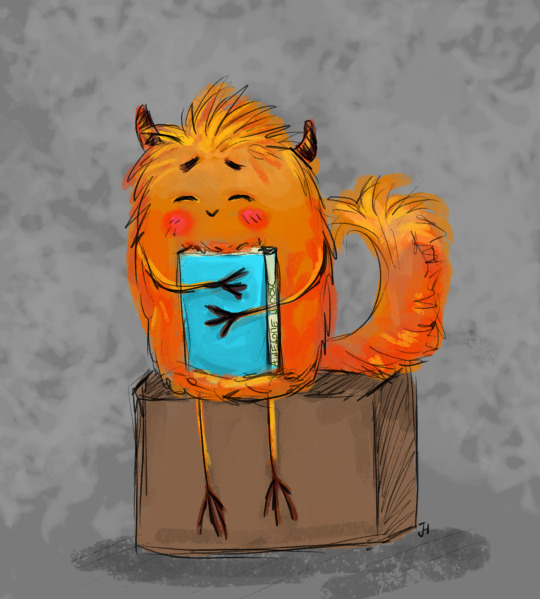
if you made it this far, here’s a smol cute book monster
#ldoo#hopebeyond#dreamshadow#storyteller saturday#thank you for asking <3#this got so much longer than I expected#apparently I needed to let out all the love???#ettawritesnstudies
4 notes
·
View notes
Text
WIP Prep (tag)
I was tagged by @paladin-andric -- thank you!!! I loved filling this out, and sorry for the delay!
Rules: Answer the questions, then tag as many people as there are questions (or as many as you can).
The Colors of War
FIRST LOOK
1. Describe your novel in 1-2 sentences (elevator pitch)
Sent from London, England to Maine, USA by her guardian to escape The Blitz of World War II, Marjorie Borchert is left to navigate her young adult years in a tight-knit and foreign town. As the years progress, she learns war stretches far beyond the front lines.
2. How long do you plan for your novel to be? (Is it a novella, single book, book series, etc.)
A single book with possibly a collection of shorts from the other character’s lives.
3. What is your novel’s aesthetic?
Chilly mountains and moose.
4. What other stories inspire your novel?
Little bits from Number The Stars by Lois Lowry and the character of Emily Bennet from the Molly American Girl series.
5. Share 3+ images that give a feel for your novel


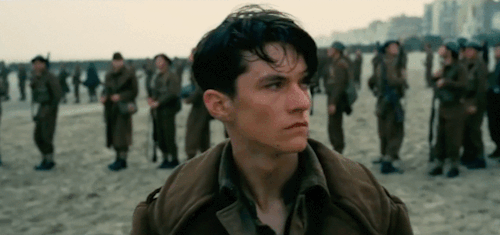
MAIN CHARACTER
6. Who is your protagonist?
Marjorie Borchert. She is in her mid-teens at the beginning of the story. Moody to say the least, but she has a big heart.
7. Who is their closest ally?
Daniel Reynard. Nikita Savas is a close second but Marjorie’s had a special bond with Daniel from the beginning.
8. Who is their enemy?
Kate, Beatrice, and Gina. Kate is the worst despite the fact Marjorie shares a room with Beatrice.
9. What do they want more than anything?
For things to be as they were before the war.
10. Why can’t they have it?
Her parents were both killed.
11. What do they wrongly believe about themselves?
She believes nobody wants her -- which is understandable after being passed off to strangers by her guardian and, in a way, her brother.
12. Draw your protagonist! (Or share a description)
I’m not much of an artist and she’d look like a cartoon, do description it is.
Tall, though not towering over everyone. She keeps her brown hair short or shoulder length until she’s older. She’s thin, possibly malnourished, when she first comes to America. She fills out a bit the longer she’s at the farm and eating three full meals a day. She’s pale, partly due to locations she’s lived. She had prominent German features, most notable, her accent which is mixed with a British tongue.
PLOT POINTS
13. What is the internal conflict?
There’s different stages I’ll say. In the beginning, it’s about Marjorie trying to find her place in this small and established community. Her biggest conflict being a target for the prejudiced Kate. Then it moves on to the progression of the war and her fears around America’s involvement. But she comes to see that war doesn’t just affect those fighting or being captured and bombed. She also sees how different people handle things differently. Priorities fall into place through this.
14. What is the external conflict?
Trying to get by and adapting to the changes the war is bringing to the community. Acceptance, too. Internal and external kind of work together.
15. What is the worst thing that could happen to your protagonist?
Losing her brother for good and/or not being able to return to England.
16. What secret will be revealed that changes the course of the story?
My only secret might not end up working. There would have to be a second book. Either way, I’m not going to reveal it. It might end up being one of things only me and a couple of my writing friends will ever know....
17. Do you know how it ends?
Yes, unless Marjorie decides to change her course of action.
BITS AND BOBS
18. What is the theme?
Acceptance and making the best of a bad situation.
19. What is a recurring symbol?
Change.
20. Where is the story set? (Share a description!)
Jackman, Maine, USA. A small town with a population under 1,000 a few miles from the border of Canada. It’s a heavily wooded area with beautiful mountain and lake views. Lots of wildlife, too. The town is small, running along a single street branching out into houses.
21. Do you have any images or scenes in your mind already?
So. Many.
22. What excited you about this story?
The time period. I’m a history buff and the 1940s has always been my favorite era.
23. Tell us about your usual writing method!
Procrastination. That’s really it. I do my best writing at five in the morning and knowing I have to pick my little cousin up from the bus in a few hours. I tag (if you’d like): @throughwordsiescape @silverscreenwriter and @rachelradner
7 notes
·
View notes
Text
How Scorn Turned the Art of H.R. Giger into a Nightmarish Horror Game World
https://ift.tt/eA8V8J
Ebb Software’s long-awaited horror shooter Scorn is designed to make you squirm in your seat from the second you lay eyes on it. Set in a gruesome world of bone, flesh, and sharp steel, the game is meant to be repulsive, but it’s also absolutely entrancing. The imagery is visceral and gory — from tendrils of meat hanging down from big, grotesque statues to the bloody creatures crawling all over the walls to the webby, diseased-looking membrane covering the skinless protagonist’s head — but you also can’t look away.
According to game director Ljubomir Peklar, the game’s visual style is meant to challenge what we generally consider to be beautiful.
“Human beings are conditioned to like the external beauty of their bodies and see the internal organs, bones, and tissue as something repulsive. It’s a reflex,” Peklar said of the game’s art direction in an interview with Rock.Paper.Shotgun in 2016. “Our existence as a living organism is at the core of the game and human anatomy is the primary subject. Therefore we referenced many different parts of it as a starting point, then we morph, combine, and exaggerate them, change the shapes until we get something visually appealing. It’s not always about functionality but interesting forms that make sense for what we are trying to express.”
It’s clear the team at Ebb is trying to express a deep fascination with the organic while also making sometimes literal connections between living things and machines. Take the game’s main weapons, the pistol and shotgun, which are living organisms with mouths where you’re meant to insert the bullets. There are ribbed cables that run through structures resembling organs, while leaking phallic-shaped mouths protrude from the metal walls.
Scorn‘s challenging and disorienting art style could make it a defining work of horror gaming, but even if it’s not, it’ll certainly be one of the most visually interesting games on the Xbox Series X when it launches later this year. You can see what I mean in this trailer of the game running on the next-gen console:
It’s no secret that this Gothic hell is heavily inspired by the work of two of the greatest surrealists to ever touch a canvas, the Swedish artist H.R. Giger, who you may know best for his designs for the sci-fi horror movie Alien, and the Polish painter Zdzisław Beksiński, whose grim creations are particularly responsible for all of the gore in the game’s environments. This isn’t the first time their work has shown up in some form in a video game, but Scorn could very well be the most faithful of the bunch.
Giger most famously collaborated with developer Cyberdreams in the early ’90s, providing access to his artwork for the psychological horror point-and-click adventure game Dark Seed and its sequel Dark Seed II. But the use of Giger’s work in that game can only be described as “quaint” when compared to what Scorn is doing. After all, the technological limitations of the time prevented Cyberdreams from truly building something out of Giger’s art, forcing the team to instead use his airbrushed paintings as backgrounds in the game to set the mood of the somewhat peculiar plot.
“Actually I think no one really did it the right way,” Peklar says of past adaptations of Giger’s work in an email to Den of Geek. “I don’t remember too much of Dark Seed, I played it a very long time ago. I do know that the artwork was just H.R Giger’s already established work collaged into the background. It was not designed from the ground up to be a setting in a game.”
Peklar asserts that no one has done what Scorn has set out to do. Peklar is not only interested in capturing the look and feel of Giger’s twisted work but also the meaning behind the pieces.
“Giger’s visual influence can be seen in many forms, from movies to games, but only superficially, to represent aliens, monsters maybe some strange planet, etc. Nobody truly dealt and realized Giger’s work thematically,” Peklar says. “His work is the most fascinating part but always sidelined, never the focus.”
Director Ridley Scott might take issue with Peklar’s comments, especially since so much of Alien‘s world is based on Giger’s unique vision, but even those movies don’t quite delve into the full breadth of the artist’s work, which often portrayed human beings in a physical, often erotic, relationship with machines, a style the artist called the “biomechanical.”
Indeed, you can see Giger’s “biomechanical” style in the way Scorn‘s protagonist “plugs into” an exoskeleton made of bone in the XSX trailer or how he sticks his arm inside of a terminal, veins like spaghetti running through the “computer’s” circuits to activate a machine in gameplay footage from 2017.
“It’s not about alien worlds, no matter how many people think that’s what his art is about,” Peklar explains. “There is a much more important subtext to it. It’s about the interweaving of human beings and technology. The organism as a structure that defined our existence up to this point, fused with our own mechanical creations in a ridiculous dance of libido and death. Freudian concepts that both move and terrify us.”
If Giger’s work emphasized the symbiosis between the living and the mechanical, the less well-known Beksiński was more interested in man’s connection to death. Many of his pieces, which often depicted dystopian settings riddled with skeletons and corpses presided over by red, bleeding skies, seem to have a singular focus: the apocalypse and what comes after.
Beksiński loved to paint decaying bodies and skeletal figures stripped of the features that once made them human, like faces and skin. One particularly haunting painting depicts a man’s eyeballs spilling — or perhaps growing out like roots — from their sockets in messy ropes of red. Beksiński’s work is likely the most responsible for Scorn‘s faceless protagonist, whose body is mostly made up of skinless muscle tissue and nerves, with the bones of a naked ribcage protruding from his chest.
Peklar tapped concept designer Filip Acovic to create the look of Scorn, from the levels to the protagonist to the weapons, but the goal wasn’t to just produce a “mere homage to Giger” or Beksiński, as the director told Shacknews in May.
“[Giger and Beksinski] are certainly the two main visual influences but their work was not chosen because it looks cool but because different aspects of their work relate to various themes and ideas in Scorn. We also tried to create our own style,” Peklar told Rock.Paper.Shotgun.
Peklar tells Den of Geek that he believes “the art style should always be in service of the themes and the ideas of the game.” But what is Scorn actually about? Peklar is more secretive about the game’s plot, which will unfold through environmental storytelling as opposed to cinematics. In fact, the director wishes he could have kept the game’s whole existence a secret for much longer than he did.
Since Scorn was announced in 2014 for PC, it has gone through two Kickstarter crowd funding campaigns and was initially set to be released as a two-part experience before announcing a full release on Xbox Series X and Xbox Game Pass in May.
“The reason you heard about the game in 2014, 2016, and 2017 was because we were running out of resources so we had to show it and gather interest so we could convince people to invest in the studio. I said it quite a few times, if I had the all the resources needed to develop the game without public knowing about it I most certainly would. You would be probably hearing about the game for the first time now and thinking it’s a new game.”
Yet, six years of cryptic trailers haven’t betrayed the secrets of a game that was “designed around the idea of being thrown into the world.” Like the Giger and Beksiński pieces that inspired him, Scorn‘s macabre dreamscapes may defy explanation, according to Peklar.
“Like the best of nightmares, that surreal imagery will start playing with your psyche the more you play the game,” Peklar told Shacknews. “When you wake up from a nightmare it’s really hard to define what you dreamt, only snippets remain, and the feeling of anxiety. That is something we are trying to recreate.”
In the Shacknews interview, Peklar compared the feeling of traversing through Scorn‘s work to the hectic opening Dario Argento’s horror masterpiece Suspiria: “It’s a montage of sights and sounds that creates the uneasy feeling. Nothing is set up story-wise and nothing truly graphic is happening. It just is.”
While Peklar looked to horror classics like Resident Evil and Silent Hill for the environmental storytelling that ties Scorn together, Peklar told PC Gamer in 2017 that he wasn’t interested in a scripted story for the game:
“We are not trying to push traditional plot-driven narrative. That is where these games fail for me. Writing an interesting story requires a good writer, and game developers or writers that specialize in games writing are not very good. If they were, they would write a book or a screenplay. That’s the right medium for the job. Games for me are about interactivity and telling you a story through it.”
Ultimately, what Scorn‘s story is about may not be as important as what players take away from it. Peklar says that he’s ultimately happy to let “players to give their interpretation of the game.”
Giger and Beksiński aren’t the only influences on Scorn, according to the director, who says filmmakers like Alejandro Jodorowsky, David Cronenberg, David Lynch, Dario Argento, and John Carpenter are also major inspirations.
“Cronenberg’s main concept that puts our organism at the center of human existence and Giger’s bio structures intersect in many ways,” Peklar says. “Lynch’s surrealness captures the strangeness of the world we inhabit and an oneiric sense of our own being.”
Peklar also cites surrealist writers Franz Kafka and Jorge Luis Borges, whom he says “mostly dealt with the absurdity and weirdness of human existence in this mysterious universe.” Then there’s horror writer Thomas Ligotti, “who deals with all the horrors that come with it,” and the dystopian J.G. Ballard, who “bounds it all together in technological nightmares of sex, violence, and decay.”
What we’ve seen and heard of Scorn so far points to this year’s most twisted game, perhaps even the most uncomfortable visual experience ever released on a console. As I rewatched the footage of the game in preparation for this article, I wondered whether Peklar was worried that gamers would find the finished product too revolting to complete or even play at all. Then I was hit with an even darker thought: was there anything in Scorn that was too fucked up for even Peklar?
When I ask Peklar whether there’s been anything he decided to cut from the game because it went too far, the director simply answers, “I’m hoping for that day to come. Either my imagination is too limited or I have become too numb.”
Scorn is out later this year for Xbox Series X and PC.
cnx.cmd.push(function() { cnx({ playerId: "106e33c0-3911-473c-b599-b1426db57530", }).render("0270c398a82f44f49c23c16122516796"); });
The post How Scorn Turned the Art of H.R. Giger into a Nightmarish Horror Game World appeared first on Den of Geek.
from Den of Geek https://ift.tt/2GEEobG
0 notes
Text
Episode 60: Keeping It Together
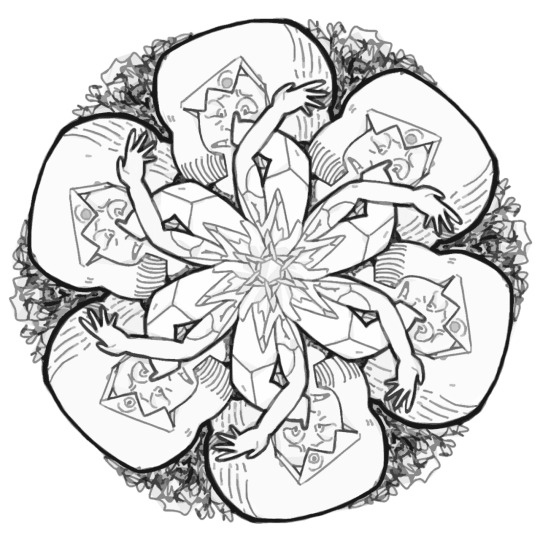
“It’s not our fault!”
Does Steven Universe have a more ominous setting than the Prime Kindergarten? Rose’s Room comes close (and I maintain that Rose’s Room is the scariest episode of the series), but episodes featuring it always pay off the unsettling setting with an actual scare. Whereas the muted colors and cacophonous clangs of Kindergarten maintain a constant thrumming dread, promising something horrible and imminent, and lets that tone linger uninterrupted. Amethyst’s fight with Pearl in On the Run is intense, and the Crystal Gems confronting Peridot in Marble Madness ramps up the suspense, but we haven’t seen any true horror from Kindergarten until now.
And yeah, holy shit.
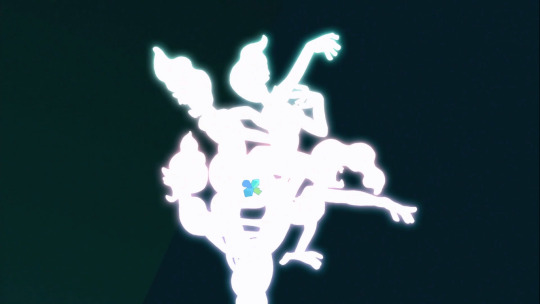
As I mentioned in Reformed and Sworn to the Sword, Keeping It Together establishes Garnet’s next big arc. But hers is much different from her fellow Gems’, both in structure (it’s the shortest by far and resolves with its Peridot Episode instead of its Steven Episode) and in tone. Garnet is the emotionally healthiest Gem on the planet right now, so she needs a bigger push than Amethyst or Pearl if she’s going to lose her cool. This isn’t to belittle the other two Gems, but there’s a reason the prompts for their episodes are day-to-day issues (for them) like renewing their physical forms or training a student, while Garnet needs dramatic scenarios like the Cluster Gems or a friend’s betrayal to reach the same level of crisis.
In short, external motivation is everything to Garnet’s arc because she lacks the internal baggage of her peers. There’s nothing unhealthy about being queer a fusion, so her problems stem from societal oppression that targets her for being who she is. We’ve seen her face fusionphobia with grace against Jasper, and we’ll see that bookended with Peridot when the season ends, but an attack on her identity as abhorrent as the Cluster Gems is certainly grounds for an extreme reaction.
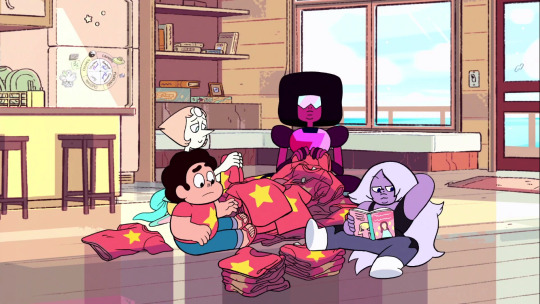
We’ll get there, but first I have to point out how well-structured this whole episode is. The opening revels in switcheroos, first with Garnet’s serious conversation turning out to be part of a chore session, then with two red herrings in quick succession: the hint that we might see Ruby and Sapphire, and an extended callback to On the Run suggesting a focus on Amethyst.
From there, the episode looks like it’s going to be about Steven settling into his own new status quo as a more respected member of the Crystal Gems. And in a way, it is! We spend a lot of time with him, and he summons his shield without any fanfare when the going gets tough. But it makes sense to focus on him more here than in Reformed and Sworn to the Sword, because Garnet’s status as a fusion is still novel to him and has changed their relationship in a way that warrants examination. And in an episode about Garnet encountering forces that don’t understand fusion to a horrific degree, it’s a soothing contrast to see Steven’s own misunderstanding come in the form of genuine curiosity.
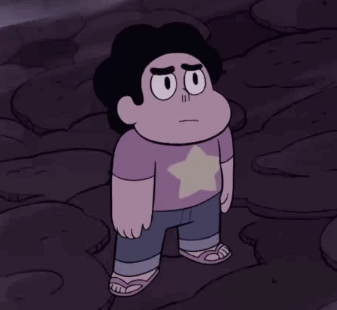
Steven is also where we get a lot the goofiness that often accompanies the show’s horror episodes, but don’t let the clip of his spectacular shrug fool you, the comedy crown here goes to Peridot. This is the episode that tips the scales on Peridot as a villain: she began as a coldhearted alien, and her bureaucratic fussiness emerged in Warp Tour and Jailbreak, but now she fully transitions from a menacing opponent to a panicky thorn in the Crystal Gems’ side. All it takes is one look at Steven to make her lose her worker bee cool, and the action scene that follows plays her increasingly absurd bag of tricks for laughs as she outmaneuvers our heroes.
Peridot’s newfound jitters make sense on a character level, as she lost her power and is stuck on a world she knows is doomed. But the silliness that ensues also works wonders for Keeping It Together’s structure: by making her such a loud source of comedy, her exit marks a concrete tonal shift from goofy to grave. And by making her someone to be pursued, we get rid of Amethyst and Pearl in the process. And by revving up to a breakneck pace to follow her zany action, we reach the third act around the episode’s halfway mark to let it sink in that much deeper. Thanks, Peridot!
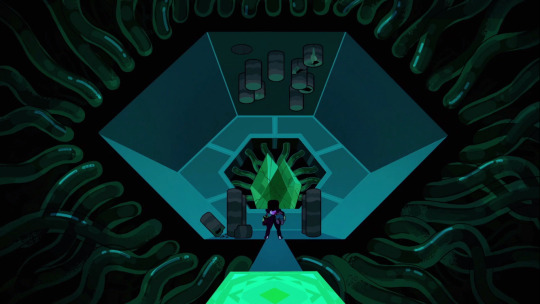
After focusing on Garnet in the episode’s onset, we’re right back to hanging out with her again. She’s even more confident than usual here, accepting Steven’s effusive praise with a simple “thank you” and acknowledging out loud that she’s great, to show us how big of a deal her panic attack is. We’ve seen her handle monster after monster without breaking a sweat, and she even defeats Jasper with a smile hours after getting destabilized. But the Cluster Gems hit her where it hurts, and seeing Garnet get rattled like this is far scarier than the monsters themselves.
Not to take away from Aivi and Surasshu’s awful Cluster Gem theme (great, but awful), but the true sound heroes of this scene are whoever designed the ungodly noises these things make. Considering nobody is credited as “Monster Scream Maker” I’ll go ahead and shout out the whole sound design team for this one: Timothy J. Borquez, Susy Campos, Tony Orozco, Daisuke Sawa, Robert Serda, and Tom Syslo. I have no idea how their jobs work, but I’m so glad they’re so great at what they do.
And then of course there the visuals, and dear lord are they upsetting. The drizzle of mismatched body parts starts small, with a hand and foot that happen to match Ruby and Sapphire’s colors taking the Gem Shard concept we’ve seen in Frybo and Secret Team to a whole new level of creepy. But the limbs get bigger and bigger until the excruciating reveal of five screaming Gem ghosts transforming into a monstrous “arm” reinforces Garnet’s pained explanation of what these Cluster Gems actually are: the remains of her long-dead friends forced together.
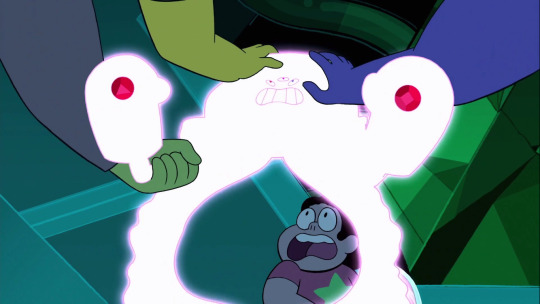
But even then, even as Garnet is literally falling apart, she manages to push through the horror and save the day with Steven’s help, leading to Estelle’s showstopping argument with herself. Where A.J. Michalka’s frequent use of separate voices for Steven and Connie shows Stevonnie’s youthful uncertainty, Estelle’s normally steady performance makes her frantic and distinct portrayals of Ruby and Sapphire a shocking swerve. It both subverts and fulfills our expectation of seeing Garnet’s two halves after Stephen brought them up during laundry, and brings home the idea that splitting up isn’t a fun party trick no matter how much Stephen (and fans) want to see more of them.
The little details here are amazing. I love that it’s Ruby’s eye that tears up during the fight, but by the aftermath she’s moved to rage while Sapphire is still reeling; one lives moment to moment, and the other thinks in the long term. I love that gaps in the conversation are filled by them clearly sharing the same thoughts, namely that Rose might have known about these experiments and kept them secret; the notion that this is even possible foreshadows how dark Rose’s secrecy is going to get in the coming episodes. And even though it’s tragic, I love that the header quote can first be read as Garnet’s guilt over being part of the rebellion that caused her friends to suffer, but can be reread after The Answer as guilt over prompting the Diamonds’ interest in fusion. It’s not her fault, but it certainly would feel like it was.
But therein lies the difference between Garnet and Amethyst/Pearl: guilt this intense would shut the latter two down, but by the end of the episode Garnet has kept it together. She’s still upset, and she should be, but she’s not letting herself drown in her sadness and anger.
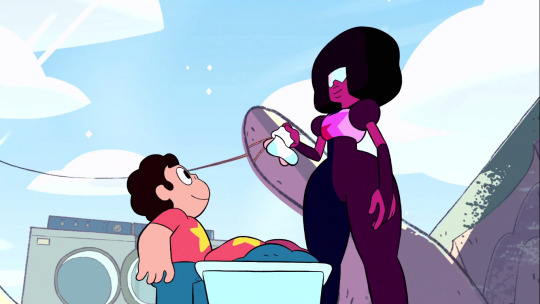
The Week of Sardonyx is about to test Garnet again, and Pearl’s betrayal can hit even harder now that we’ve explicitly been told about the importance of consent in fusion. And as I hinted at earlier, fusion’s multipurpose metaphor extends to a specifically queer reading that’s vital to Garnet’s arc. I honestly wouldn’t mind being hammered over the head with the message that homophobia is bad, because yeah, homophobia is bad and kids should know that and children’s media doesn’t bring it up very often. But like everything to do with fusion, the Steven Universe team handles the allegory factor with incredible finesse. There’s no one-to-one analogy between fusion and queerness beyond Ruby and Sapphire both presenting as female; indeed, the mistreatment of queer people in the real world rarely includes forcing them into long-term relationships with each other a la the Cluster Gems, and Homeworld society only finds fusion acceptable in same-Gem relationships, so it’s actually heterophobic if we want to get stupid and pedantic.
This show doesn’t need an episode about conversion therapy or corrective rape to display the horror of an outside force perverting what you are and oppressing who you are, and Garnet’s journey through Season 2 shows that Steven Universe isn’t content with presenting two women in a relationship and patting itself on the back for being progressive. The fact that the show addresses homophobia with sensitivity but without pulling punches is something entirely new, but the fact that it’s doing so while enhancing a character and advancing the main plot is even more outstanding.
Future Vision!
The headline here may be kicking off Garnet’s arc, but it also revs up the Cluster Arc: these shard fusions are bad, but who could’ve guessed they were apocalyptically bad?
Peridot’s surprising resilience to large objects and gravity is as true in the Beta Kindergarten as it is in the Prime, if Kindergarten Kid is anything to go by.
The question of whether Rose could’ve known details about Diamond tactics reframes Sapphire’s rage in Now We’re Only Falling Apart.
If every pork chop were perfect, we wouldn’t have inconsistencies…
As great as Steven is here, would he really be that surprised that he’s coming along? I get that they’re showing that the status quo of getting some respect is still new to him, but yeah, after saving everyone in Jailbreak I think he’s pretty official. Enh, just a gripe, it’s implemented well enough.
We’re the one, we’re the ONE! TWO! THREE! FOUR!
I think just above On the Run sounds right for Keeping It Together. It’s a terrific Garnet episode with a welcome side of Peridot, and manages to set the stage for a new arc while culminating Kindergarten’s foreboding tone with a bang.
Top Fifteen
Steven and the Stevens
Mirror Gem
Lion 3: Straight to Video
Alone Together
The Return
Jailbreak
Sworn to the Sword
Rose’s Scabbard
Coach Steven
Giant Woman
Winter Forecast
Keeping It Together
On the Run
Warp Tour
Maximum Capacity
Love ‘em
Laser Light Cannon
Bubble Buddies
Tiger Millionaire
Lion 2: The Movie
Rose’s Room
An Indirect Kiss
Ocean Gem
Space Race
Garnet’s Universe
The Test
Future Vision
Marble Madness
Political Power
Full Disclosure
Joy Ride
Like ‘em
Gem Glow
Frybo
Arcade Mania
So Many Birthdays
Lars and the Cool Kids
Onion Trade
Steven the Sword Fighter
Beach Party
Monster Buddies
Keep Beach City Weird
Watermelon Steven
The Message
Open Book
Story for Steven
Shirt Club
Love Letters
Reformed
Rising Tides, Crashing Tides
Enh
Cheeseburger Backpack
Together Breakfast
Cat Fingers
Serious Steven
Steven’s Lion
Joking Victim
Secret Team
Say Uncle
No Thanks!
4. Horror Club 3. Fusion Cuisine 2. House Guest 1. Island Adventure
(No official title card for this one, likely due to Keeping It Together being part of a Steven Bomb, but luckily this piece from Vondell Swain will do.)
33 notes
·
View notes
Text
New from Every Movie Has a Lesson by Don Shanahan: COLUMN: The 10 Best Movies of 2019

Before talking about this year-end best list from one of the most back-loaded ones in recent memory, reflection is needed and a deep breath for the next decade to come. I am forever proud of what I do. I wouldn’t chase all the press opportunities and commit the time into it if I didn’t. In 2019, a great deal of change came to me and this website of mine this past year. I am forever proud of what I do.
The critics group I helped found and co-direct, the Chicago Independent Film Critics Circle, rebranded into Chicago Indie Critics. We celebrate our fourth annual awards this week and our industry reach and reputation grows every year. Best of all, it’s a pleasure to count my peers there as friends in the press row trenches. It’s nice to share smiles and handshakes at every screening I can.
Speaking of professional standings, I answered a call for writers and began contributing for another website this year. Since June, I’ve been providing film reviews for 25YL, short for 25 Years Later. Founded by Andrew Grevas, what started as a Twin Peaks tribute site has turned into “all your obsession in one place” to cover a wide range of entertainment. I became their first Rotten Tomatoes-approved film critic and have greatly enjoyed the new audience, increased exposure, and a chance to be a part of a bigger thing.
Here on Every Movie Has a Lesson, this was the first year the site has featured monetized ads. I’m no longer doing all this for free, so thank you for dealing with the visual noise to help pay the bills. Also, my site has been open to guest writers looking to get published. I was honored to help an astounding 44 writers get their work seen in 2019, including 21 Washington State University architecture graduate students with their movie-centered essays. This school teacher couldn’t resist helping folks and I’ve enjoyed their content and contributions.
Alright, let’s get to the scoreboard. In all, I published “only” 94 film reviews in 2019, which is plenty, but down from 110 last year and my high mark of 126 in 2017. I saw a dozen and a half more, but full-time school teachers, husbands, and dads like me only have so much free time to put 1000 words down every time. Work-life balance, so to speak, is always a challenge, one that I aim to do better in the life direction. No matter, I think I’ve got 2019 figured out. Here are my picks for the ten best films of the year accompanied by, as always and true to my site’s namesake niche, their best life lesson:
THE 10 BEST MOVIES OF 2019 AND THEIR LESSONS
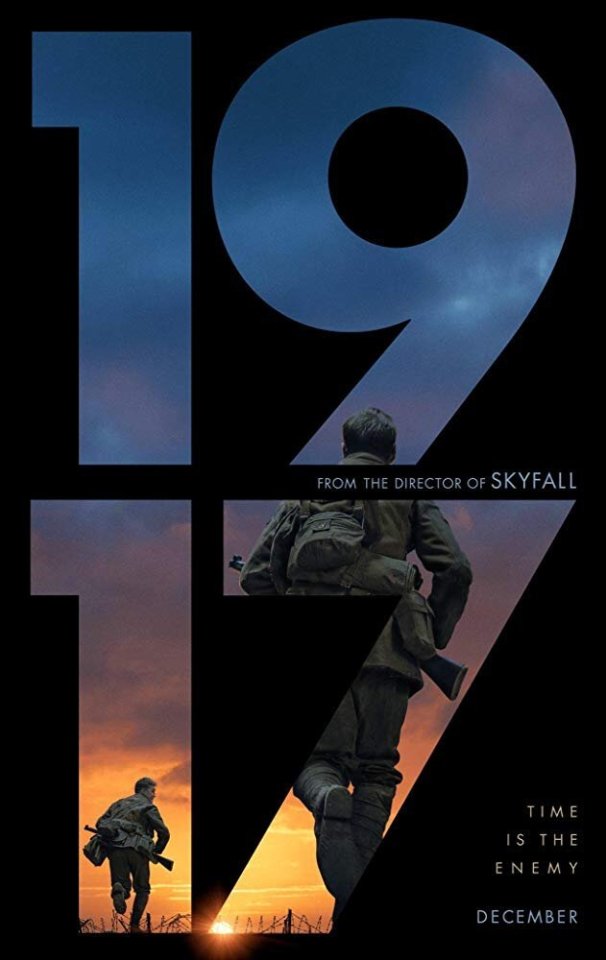
1. 1917
Full Review
I’m going to sound like an Olympic figure skating judge, but no film received higher technical marks on my scorecard in 2019 than Sam Mendes’ harrowing war thriller. At the same time the filmmaking prowess captivated me, I was overwhelmingly swept up by the human elements as well creating a complete experience. Most people haven’t seen it yet and I cannot wait until you do.
BEST LESSON: WAR MUST BE ENDURED— All of those World War I combatants from over a century ago, including a family member of the Mendes lineage named in tribute during the end credits, may not be distinctly special or flush with a mythic history of certain destiny. Yet, what they endured was shattering and strengthening at the same time. The draw to see summoned bravery and weatherd tragedy in conflict will always be hugely magnetic. Rising with ambitious scale and a colossal level of enthrallment, 1917 will join cinema’s greatest exemplars of such captivation.
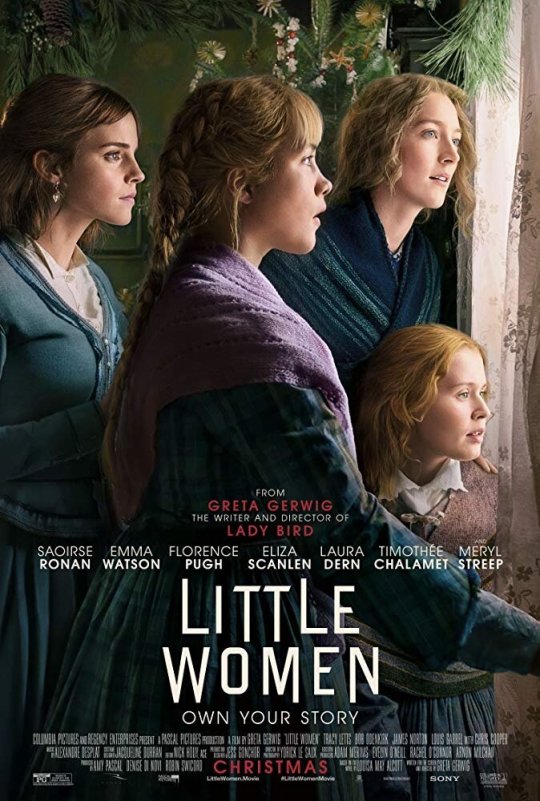
2. Little Women
Full Review
Greta Gerwig took Louisa May Alcott’s seminal novel, something that could have easily been stiff and stale, and brought new spirit to it. Yet, in doing so, she didn’t force anything. She didn’t shove showy modernity into faces, just for the sake of doing so. Her Little Women is a mainstream PG rarity. The spirit she, the cast, and the artists brought was genuine, sumptuous, and vivacious. What a marvelous achievement!
BEST LESSON: THE STRENGTH OF FAMILIAL LOVE — To borrow this time from the Greeks and a dollop of The Bible instead of the Fab Four, the level of “storge” love in this saga is exquisite. When family is in need, the annoyances and competitiveness of these sisters go away and bonds are renewed. As they say in the dialogue, “life is too short to be angry at sisters.” Once again, thanks to Gerwig’s tonal choices, you see it, plain as day, in the way the cast in character interacts. The emotional wreckage that results is incredibly genuine.

3. Marriage Story
Full Review
Neck and neck with Little Women comes the Netflix drama with the courage to bare truths from the maddening and draining process that is divorce. Thanks to dynamite and Oscar-worthy lead performances from Scarlett Johansson and Adam Driver, heartstrings are plucked, tightened, and unraveled by Noah Baumbach’s deeply personal tale of resiliency.
BEST LESSON: WHAT WOULD YOU DO? — It is impossible to watch this movie and not have it be a barometer check towards your own relationship status and integrity. Regardless how much yearning desire floats every now and then in Marriage Story, this trauma recovery. Normally in movies like this, we see the indiscretion itself, then the collapse, ink hitting paper, and maybe a gavel banging for a suspenseful decision. Few films go in between and beyond those decision points to show the fractured orbits and restarts of continuing life with heart and honesty. There is blame to be shared, but you feel for both leads and wonder about yourself externally. That is a substantially powerful effect of this film.

4. Luce
Full Review
Until the awards season parade of November and December releases arrived, this was my #1 in the clubhouse coming out of the fall. Even though this is a wildly fictious morality play stretched into the settings of cinema, this movie gave me, the school teacher, a jaw-dropping heart attack. Between Luce and Waves, you need to keep an eye on Kelvin Harrison, Jr., a certain star for this new decade.
BEST LESSON: VENDETTAS ARE PROBLEMATIC — Simmering behind classroom smiles, what the mounting drama of Luce becomes is a straight-up vendetta, one between teacher and student. The bloodless lines of bitterness fortify to hurt people and force chosen sides. This is a saint versus a monster, with little middle, and a guessing game of which one is really which. It’s a battle the actors sell without flaw.
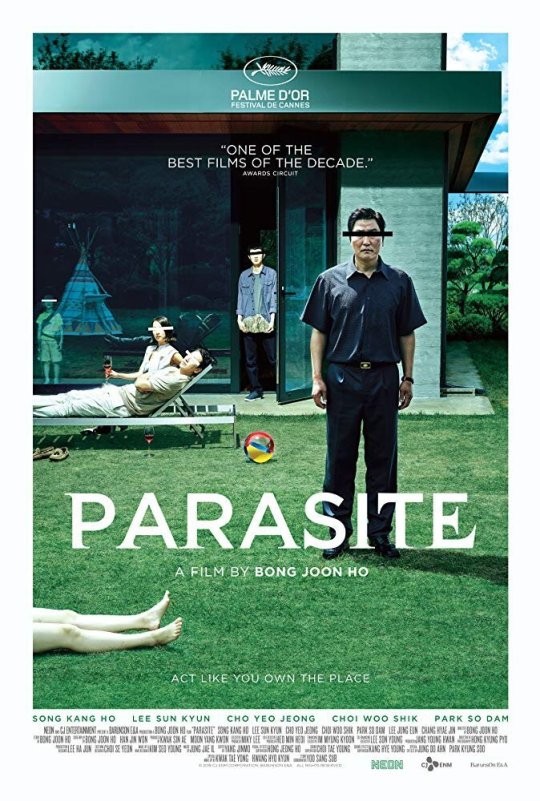
5. Parasite
Full Review
I was better late than never to this party for the most talked about niche film of the year. Leave it to a foreign director in the form of Korean Bong Joon-ho to blow our American minds with the sharpest social commentary of a film this year. Parasite’s bottle film suspense comes from the smartest and most cunning premise and screenplay of the year. Subtitle-haters, get over your hangup and see this movie.
BEST LESSON: THE DEFINITION OF “PARASITE”— When you dig into this title (as it digs into you), three variations of meaning present themselves:
an organism that lives on or in an organism of another species, known as the host, from the body of which it obtains nutriment.
a person who receives support, advantage, or the like, from another or others without giving any useful or proper return, as one who lives on the hospitality of others.
(in ancient Greece) a person who received free meals in return for amusing or impudent conversation, flattering remarks, etc.
You read those definitions and wonder, gosh, which one of the three will this buzzed-about Korean film seize or probe. Big or small, any one of them could take a toll. The staggering thing is, with many flourishes, Parasite, is all damn three of them, in twisted and overwhelming fashion.

6. The Peanut Butter Falcon
Full Review
The Peanut Butter Falcon was one of a few “Little Engines That Could For Me” this year. I couldn’t be more pleased that this labor of love and offbeat road movie, starring Zach Gottshagen and Shia LeBeouf, has been able to find a sizable audience. There’s always one movie a year that becomes my top casual recommendation when people ask me for something that haven’t heard of that is simply a good time. This is the one for 2019. This is independent filmmaking done right.
BEST LESSON: HAVE A GOOD STORY TO TELL WHEN YOU DIE — The Peanut Butter Falcon doesn’t just tell a good story. It tells a great one worthy of attention, praise, and undying appreciation. The purifying freedom that churns throughout this movie could cultivate even the most barren heart. This little lovable film is the kind of experience that makes one rethink how their own story is going. That is a mighty, motivating accomplishment for something that couldn’t stand out more from the usual summer blockbuster fare.

7. The Farewell
Full Review
Plenty of critics like myself (though I try so often to say it other ways) will use the expression “through the wringer” often when it comes to weathering difficult or excitable experiences at the movies. Well, no movie executed that as many ways this past year than Lulu Wang’s family dramedy. It’s got the comedic peaks and the dramatic ones that both crush with frank honesty and genuine love. The premise of this movie is the curveball of curveballs.
BEST LESSON: COULD YOU DO THIS WITHIN YOUR OWN FAMILY? — The crux of The Farewell makes for several of those soul-searching quiz questions every viewer must ask themselves in a film plot as specific as this one. Should, or even could, you carry on like this? To do so would be illegal in the U.S. Can you justify your position? How long could you live with or act out what everyone calls a “good lie?” Is there even such a thing? In this culture, it is characterized as the family carrying the emotional burden for the dying. Sure, but if you’re helping them, who’s healing your internal injuries of the heart living with that weight? How you answer these will inform your connection to this film straightaway.

8. Joker
Full Review
I found what has stood to be become the most polarizing movie of the year to be one of the year’s best. Go ahead and judge me. Called a masterpiece by some and trash by others, I fall definitely on the high end with this maniacal comic book tangent. Joaquin Phoenix was too good to ignore. On every level, I admire the sheer cajones of this blockbuster to pulverize us with kitchen sinks filled with cajones and questions.
BEST LESSON: THE DEFINITION OF “GALL” — According to Dictionary.com, the four possible meanings of the noun span impudence, severity, bitterness of spirit, and rancor. To saunter a little cruder, which is fitting for the movie in play, the Urban Dictionary defines the word as audacity, balls, or something risky. Hot damn, Joker is each one of those descriptors from both sources and then some.

9. Jojo Rabbit
Full Review
Yes, it is categorically crazy to reach a point of embracing a movie about Nazis, but leave it to Taika Waititi to pull it off. He imbues enough heart into this satire to present a transformation of wrongs into rights that is entertaining and affecting in its own way. The filmmaker said he was making a movie of hope and love that could echo into our own present times. He did that with infinite panache without sacrificing hard reality.
BEST LESSON: WHEN ACTUALITY HITS — Using the word “reality” in this comical setting is leaping too far. Stick with actuality instead and just look at the objects and actions. Knives hurt people. Grenades explode. Soldiers die. War destroys. Germans are fallible. Jews are regular people too. When the wrongs and horrors of war arrive, the movie shifts. Jojo Rabbit swells and elevates beyond farce with this actuality.
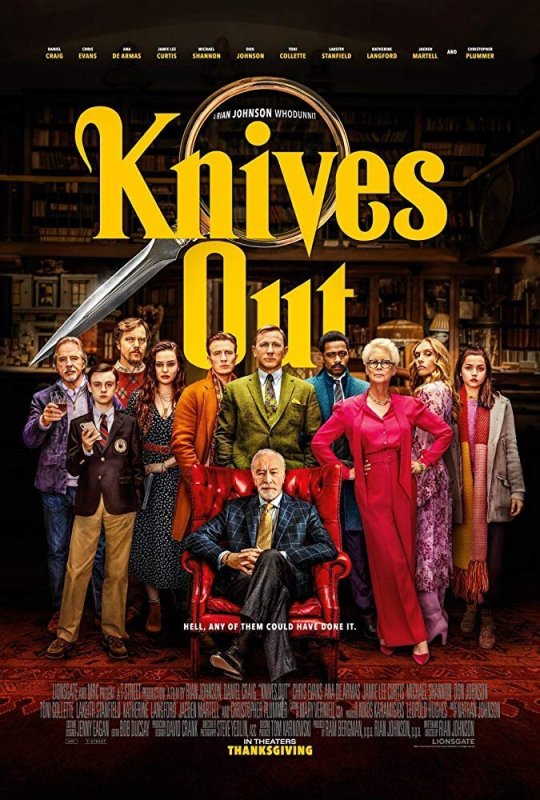
10. Knives Out
Full Review
This will sound poster-quote cliche like that “wringer” sentiment over in The Farewell at #7, but Knives Out was flat-out the most entertaining film of the year for me. To name-drop a film lower down the list, the second most entertaining and surprising one was The Man Who Killed Hitler and then The Bigfoot at #13. Back ti Knives Out, my review says it all deeper and better than cliches, but Rian Johnson absolutely nailed subverting the murder mystery blueprint to create pitfalls of depravity and delight. Everyone involved is clearly having a blast and we do too.
BEST LESSON: HOW TO SUBVERT AN ENTIRE GENRE — The trope-filled mechanics of most murder mysteries create an antagonist while Knives Out has you pining for the killer instead. In flipping the rooting interests from the pursuing authorities to the identified perpetrator, the dexterous filmmaker shifted goals and bolstered energy to a different gear. Where the typical pulse rate of this kind of story opens and ends with a bang between a tedious, saggy middle, Knives Out is all about that rich center. What an equally delectable and sinful treat it is!

SPECIAL MENTION: Apollo 11
Full Review
I don’t see as many documentaries as I should, and I don’t find it completely fair ranking them alongside feature narratives that have completely different purposes, crafts, and objectives. That said, the argument can be had that Apollo 11 was the best thing to touch a silver screen this year, no matter the discipline and genre. Edited like a bullet from thousands of hours of content and tuned to IMAX perfection, this chronicle of the first lunar landing mission was incredible in every facet. I’ll be the school teacher that sees every science student in the country needs to see this documentary.
THE NEXT 10:
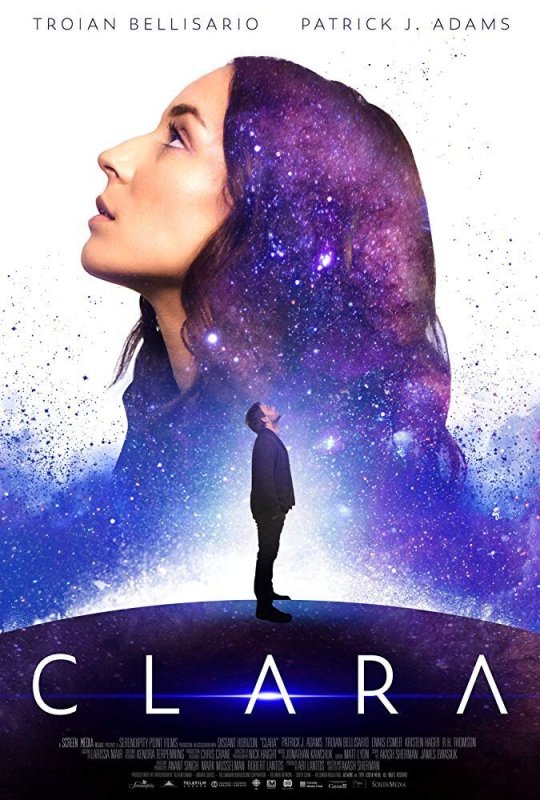
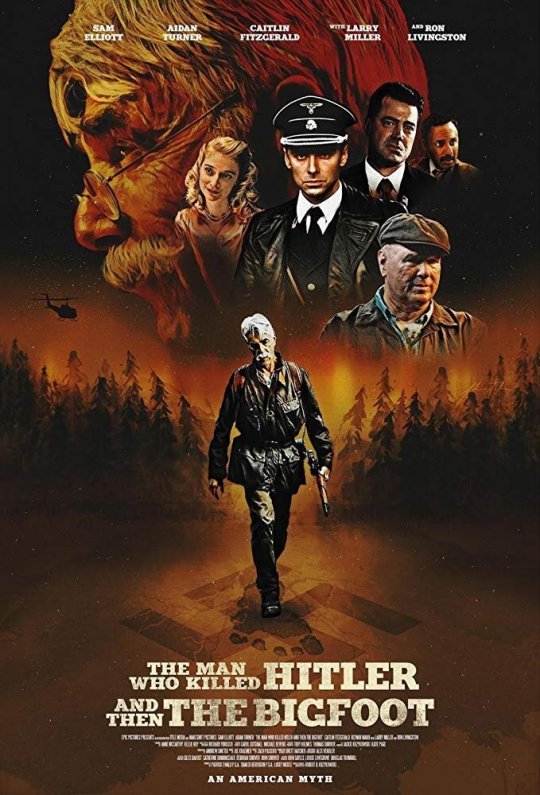


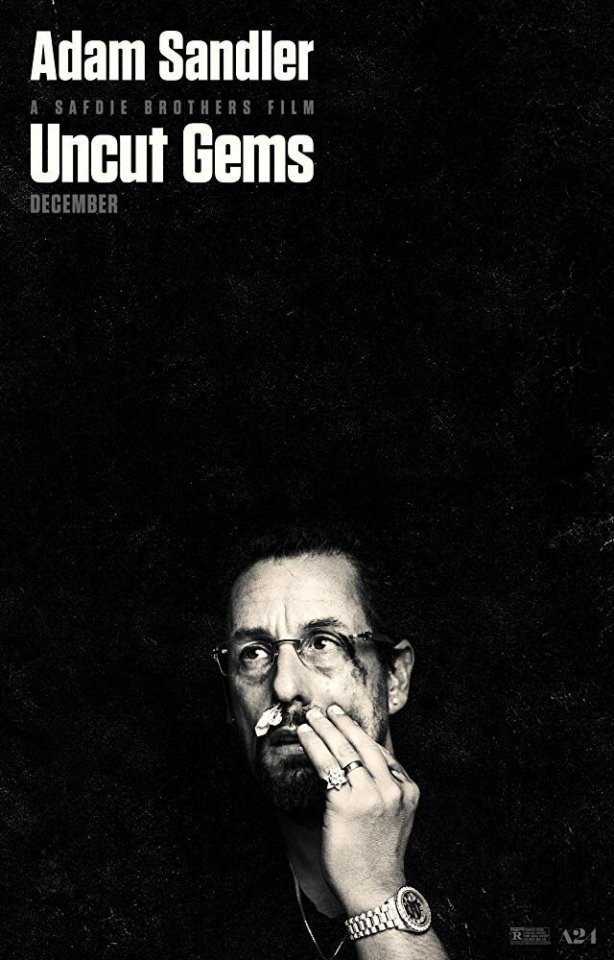
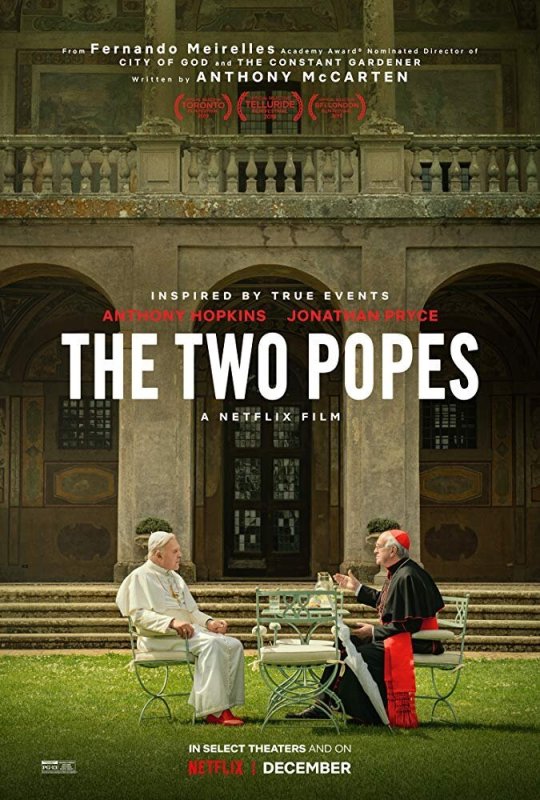

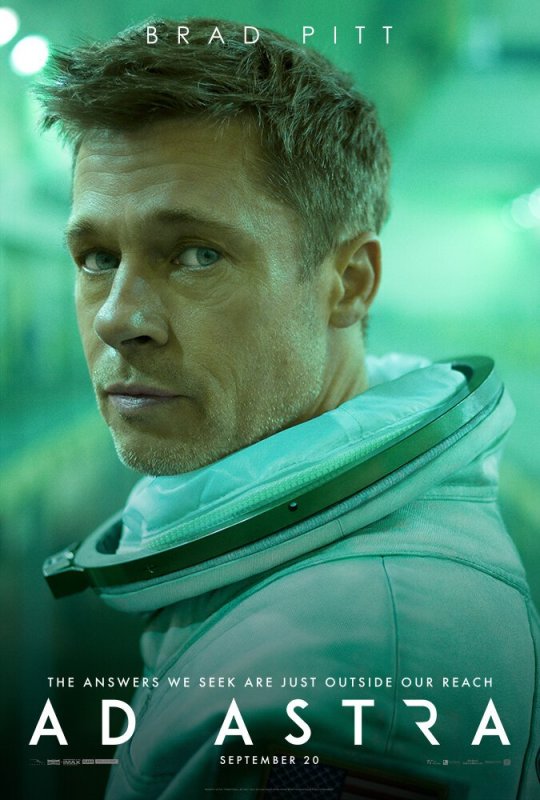

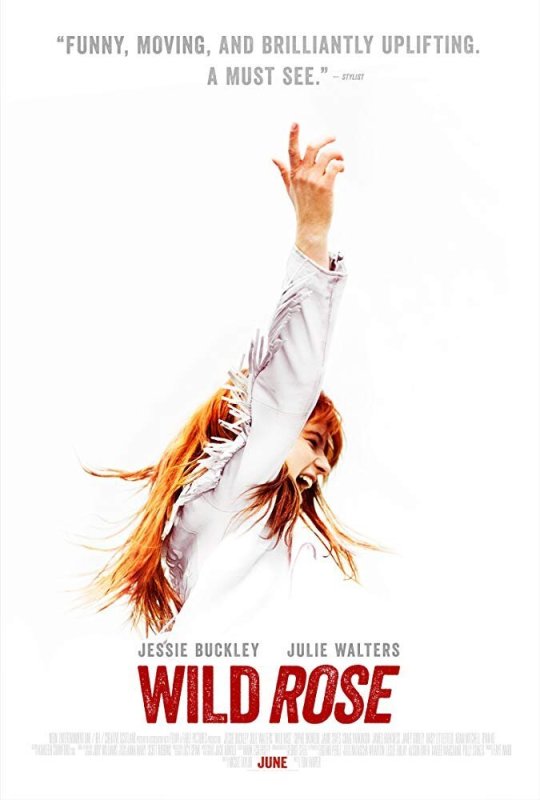
11. Clara
12. Booksmart
13. The Man Who Killed Hitler and then The Bigfoot
14. Us
15. Uncut Gems
16. The Two Popes
17. Waves
18. Ford v Ferrari
19. Ad Astra
20. Wild Rose

LOGO DESIGNED BY MEENTS ILLUSTRATED
Permalink
from REVIEW BLOG – Every Movie Has a Lesson https://ift.tt/35gE8pV via IFTTT
from WordPress https://ift.tt/2rQCYni via IFTTT
0 notes
Text
Hellblade: Senua’s Sacrifice is a shaky but triumphant step forward for the narrative potential of video games

So many game plots involve stock-standard external conflicts. Some evil person or monster wants to destroy the world or become a totalitarian leader or just cause general chaos, and it’s your job as, for whatever reason, the only person gifted enough to do anything about it, to put a stop to this evil. Obviously, these plots are usually afterthoughts to a game that focuses much more on play mechanics and visual and sound design rather than actually telling a meaningful story, and to a certain degree, that’s okay. Games are a particular medium where the most engaging story often comes not from the cutscenes you’re watching or the text you’re reading, but the story you yourself create as you interact with the game world. 2017 has so far been a watershed year for emergent storytelling, probably most notably with The Legend of Zelda: Breath of the Wild, which gave players the tools to shape the tale of their journey in ways that could far surpass whatever actual plot the game tried to tell, and has been lauded as a masterpiece for it. To a degree, though, this is a reflective form of storytelling, and as much potential for player creativity as it has, the end result is often limited to the story the player already had in her, and she remains unchanged by, say, being receptive to a story foreign to her.
On the other end of the narrative potential of video games is the a story told from the end of the creators of the game, but whose interactivity emphasizes empathy for the character far greater than a film or literature could. That’s the kind of game Hellblade: Senua’s Sacrifice is, a rare game in which the conflict is internal, and the character the player controls is not a blank-slate superhero out to destroy evil, but a tragically broken and tormented human whose biggest enemy is her own mental health. It’s a bold concept, and while its significant step forward in the narrative potential of games is undoubtedly a shaky one, it’s a step forward nevertheless, and one worthy of admiration.

At the start, as the in-game credits roll, the first name billed is for its Mental Health Supervisor. In fact, as the featurette that accompanies the game reveals, there was a team of experts in the particular form of psychosis the game’s protagonist, Senua, experiences involved with the development of the game, as well as several experiencers themselves, who had their own particular insights shared and represented in the game. The lengths to which Ninja Theory went to ensure that this game was not only as accurate to the true experience of psychosis, but sensitive and non exploitative as possible, are commendable. For as unsettling or downright horrifying as some sections of this game can be, it never feels fucked up for the sake of shock value, but rather a genuine, unflinching look at the living nightmares some must deal with as a part of their daily lives.
The other research that was invested in this game was of its setting and the mythology associated with that setting. Senua is a young Celtic warrior of the Pict tribe during the time of frequent viking invasions, and the game is thus very informed by Norse mythology, told through Senua’s spiritual guide, Druth, as she leads herself into the underworld to save the soul of her dead lover, whose severed head she carries with her at all times. In order to do so, she must fight hordes of...something. Dead spirits? Viking warriors warped in horrifying ways? Actual, creepy-crawly monsters? Facts in this game, including just the general plot of the whole thing, tend to be rather nebulous, and this is by design. Essentially, all this adversity is a product of Senua’s hallucinating, delusional mind, but rather than save this revelation for a lame reveal at the end, as some games have been known to do, it gets it over with at the very beginning, making the point of it not what is actually, physically happening to Senua, but what these manufactured enemies represent.
Combat with these enemies is fairly straightforward, a kind of Souls-y lock-on/dodge/attack kind of deal, but mechanically stripped down to the point where the only real challenge comes when these enemies start attacking in groups. It’s effective in short bursts, but towards the end can start to become a bit tedious. For me, a lot of the drama of combat came from desperately not wanting to die as a result of the warning the game gave me after my first fight: Senua is “cursed,” and this curse manifests physically as a black kind of gangrene that spreads further up her arm every time she dies. If it finally reaches her head, she’s dead for good, and you have to start over from the beginning. In the time since it came out, the exact details of this have become a point of contention. One website claimed to prove by dying over and over again in the same spot to no consequences that the permadeath feature was a hoax, but others came out claiming that it is most definitely real, but was a bit more complicated than just getting stuck on one spot would reveal.
I haven’t done a tremendous amount of research on the topic, but I have yet to find anything resembling a definitive answer to this. I’m also not particularly concerned with doing so, because for me, whether or not I really “believed” there was a particularly real chance of me actually losing all my progress, I found it to be an effective tool for the roleplaying aspect of the game. Senua believes that it is the case that she’ll die once the curse reaches her head, and the game so effectively put me in the head of this character, that I couldn’t help but see the world as she saw it. Death wasn’t just frustrating or annoying, it was downright terrifying, my sense of dread ratcheting up each time I saw the curse crawl further up Senua’s arm. With this in mind, the combat still isn’t perfect, but it builds a unique sense of desperation that few games have managed to inspire in me.

There is a certain amount of puzzle-solving as well, and while this, too, is simplistic, it ties together well with the game’s themes and plot. Those who experience psychosis tend to make connections between concepts and objects that most wouldn’t make, and Senua does the same. There’s something fitting about puzzles built around the compulsion to recognize a certain shape written on a door before being about to walk through that door, or to see the world differently depending on at which direction one passes through an archway.
That said, it’s hard to define Hellblade as a particularly “fun” game. The overall mood set by Senua’s descent into madness is hardly one that’s pleasant to be in, but that’s not really the point. One of the most regularly unnerving parts of the game is the incessant chorus of voices in Senua’s head, whispering words of doubt, fear, and antagonism. The game utilizes binaural audio recording techniques to give the listener a sense of 3D sound, and as such, playing it with headphones is both by far the best way to experience it and also kind of torturous. The combat and the puzzles of this game are just engaging enough to push the player through to further character development or revelations of Senua’s past, much of which deals with not only her failing mental health growing up, but how the rest of her community, most particularly her father, reacted to it. It’s a grim, nightmarish world to be in for the 6-7 hours that the game lasts, and it’s all the better for it, but it’s not an experience I’d want to relive any time soon.
To pass off all of my issues with this game as being by design, though, wouldn’t be fair, as there’s more to it than that. First of all, while the shallow nature of the combat and puzzle-solving would have bothered me more if the game had gone on any longer than it did, even with the current length they started to wear pretty thin towards the end. And I also couldn’t help but feel that with a game that feels as progressive as this one does, a lot of the mechanics of it come down to some pretty standard video game-y stuff. It’s not that graphic violence feels inappropriate in a game like this necessarily; given the nature of what many people with Senua’s condition experience, this is a properly gritty depiction. But there’s just something so obvious and kind of almost silly to portraying Senua’s psychological conflicts as actual combat with swords and big scary dudes to chop down. The game sells it well, but it feels like somewhat of a lost opportunity to not build a different gameplay mechanic around something slightly more personal. The limited development of the combat makes it all the easier to question the nature of its purpose in a game like this. Even the name Hellblade feels like an odd cheapening of the pretty serious nature of the game; just Senua’s Sacrifice would have been a perfectly fine title on its own.
Of course, I’m making complaints like these, which I’d never make about, say, something like DOOM, because the promise of this game is just so damn exciting, and what it does well is done very well. It’s the kind of game that opens one’s mind to the artistic potential of video games, but simultaneously shows how far the still-new medium has to go as an artform. The fact that it really does achieve the former makes the latter feel like an inevitable and acceptable consequence; progress is made one step at a time, and though Hellblade’s step forward is a shaky one, it’s also a triumphant one. It’s the kind of game I’d like to imagine will be looked back upon in a few years as a turning point in realizing the narrative potential of video games, and that kind of significance more than makes up for its specific flaws.
8.9
2 notes
·
View notes
Text
‘Supernatural’ season 14: What we know – and what we want
Supernatural will be back on our screens in exactly one month. Here’s what we know so far about season 14 – and more importantly, what we hope it all means.
On October 11, Supernatural returns to the CW with a 14th season, which will include the ridiculously resilient show’s 300th episode. Filming has been underway since July, and ever since San Diego Comic-Con, more and more tidbits have been shared, painting a picture of what fans can look forward to when the season kicks off next month. We’ve rounded up the most important details and had a crack at deciphering what these teases could actually imply.
Shorter is actually sweeter
What We Know: It’s been fairly widely reported that season 14 will be reduced to 20 episodes, from a previous 23. Supernatural has enjoyed quite a few years with an extended season – this will be the first year since season 7 to have less than 23 episodes, and the shortest overall since the cut-short season 3 a whole decade ago (ah, Writers’ Strike. We’ll never forget.)
This isn’t the CW losing faith – the decision was apparently made at the request of stars Jared Padalecki and Jensen Ackles, who obviously appear in every single episode and have done so for the past 13 years – a heavier workload than most on TV these days. This slightly shorter season gives them a longer summer hiatus, more rest throughout the year and and more time to spend at home (each is the father of three very young children) and if the stars don’t feel burnt out, the show has the potential to run for many more years to come.
Which, it seems, may be a possibility. A few years ago, questions were raised about Supernatural calling it a day at the 300th episode milestone, and we’ve been poised for an announcement ever since. However, that day fast approacheth, and the show apparently has no end in sight. Showrunner Andrew Dabb spoke rather candidly with UK print magazine SciFiNow about that potential, revealing that “[he] would be very surprised if this was our last season,” and that the writers are not approaching season 14 creatively as if it was the show’s last. Nor have they gotten any sort of heads-up from the CW to assume as such.
The season’s first 11 episodes have been released by SpoilerTV, and while we don’t know who dished this out to them, these reports have generally turned out to be accurate. So far, we’ve got 14.01 “Stranger in a Strange Land,” 14.02 “Gods and Monsters,” 14.03 “The Scar,” 14.04 “Mint Condition,” 14.05 “Nightmare Logic,” 14.06 “Optimism,” 14.07 “Unhuman Nature,” 14.08 “Byzantium,” 14.09 “The Spear,” 14.10 “Nihilism,” and 14.11 “Damaged Goods.”
The Supernatural crew’s “SPN Tape Ball” welcomes everyone back for season 14
What We Want: With a smaller episode count, the universal expectation from actors, writers and fans seems to be all about cutting the fat. Supernatural has a long and meandering history – it’s always had the time and the scope to deviate from the path and do standalone episodes, drawn out mythology reveals, and multi-season slow burn plots. It’s a wonderful opportunity which has made the show one of a kind, but it’s also a slog for everyone involved creatively, and so this year is all about honing the story to hit harder and have a more intense pace.
As most viewers are keenest on character-driven drama, we’re hoping that season 14 will be more personal, more insular and more concentrated than ever before – we want to see every episode as a clear and cohesive part of a whole, and relegate anything procedural, like casework, to an incidental background element of the characters’ day-to-day lives, while their minds are still on the season’s major external threat or internal struggle.
That seems to be the plan, according to cast and producers, and this is great news to anyone who loved season 13, because this approach was taken last year too – “Scoobynatural” was the season’s only genuine standalone, and the season was tighter and more emotionally consistent than the show has been in years. In the Digital Spy interview referenced earlier in this section, the EPs openly admit that it’s sometimes been hard to stretch their core stories over a 23 episode order, so the chance to trim anything that previously would have been added in merely to pad stories out means that what we’ll see in season 14 should be the best of the best – every moment counts.
The title reveals are all very interesting – this show has historically had some of the most wide-referencing and meta episode names in TV history, and while some of these are typical Supernatural (“Stranger in a Strange Land,” from Exodus 2:22; “Gods and Monsters” from Bride of Frankenstein) most of these are pretty simple statements, but a lot of them feel significant as pairs: “The Scar” and “The Spear;” “Mint Condition” and “Damaged Goods;” “Optimism” and “Nihilism.” The production credits are known for the episodes that have already been filmed, and so it will be interesting to see whether those similarities are actually true thematic pairs by the same writer.
As for the show’s eventual ending? More than anything we want advance notice. The various interviews that the cast and producers have given about the shortened season 14 seem to imply that the network want the seasons to be as long as possible and the stars want the seasons to be as short as possible. We hope that they continue to meet in the middle, and when Supernatural does call it a day, we want at least two seasons’ notice. Given the amount of time that the show has been on the air, any wind-down arc would need that much planning to feel satisfying and justified, and given that that wind-down apparently isn’t currently being worked on, anything less would be a total rug-yank.
Michael is a game changer
What We Know: Michael will be fully in control of Dean’s body, and he will be sticking around for a while. We will allegedly see – for the first time ever – episodes that will not feature Dean Winchester as a credited character, despite Jensen Ackles’ performance, and Ackles very thoroughly confirmed that he’ll be playing the character longer than the audience will anticipate.
Ackles previewed his new character for us at SDCC, explaining that Michael sees the Apocalypse World’s annihilation as a failure, so he’ll take a different approach here, and will begin looking for allies. “Michael is essentially looking for a race of people or animals or creatures to save, and then he will start his cleansing,” the actor explained, and he’s also spoken at length, to multiple outlets, about the challenge of shaking off Dean in an environment he’s so comfortable slipping into character in, and how he’s gotten more coaching and feedback than he has received in years. We got to see a video of a Michael scene, in which the archangel approaches a potential recruit, and we also learned that his fighting style will be very ethereal and hands-off.
Sam, of course, will be doing all he can to rescue his brother, while juggling the responsibility of being a combination military general/RA/social worker for a large group of hunter refugees who are stuck living in his house, and they’re going to run him ragged – in the first few episodes, Sam will sport more facial hair than usual because he literally hasn’t had a spare second to shave. Sam may well have this a huge group of new hunter friends all keen to help vanquish the enemy, but according to Jared Padalecki, he’ll also have to beat them to it, because their priority is killing Michael, no matter what, whereas Sam’s is, of course, protecting Michael’s vessel.
When the brothers are reunited – it looks like this will happen in episode 3, but there may more to it – expect to see plenty of PTSD as Dean is forced to relive and remember all the things Michael did with his body. This is how we’ll get to see Ackles’ performance as Michael thread through the whole season – it sounds like Dean will have plenty of flashbacks to being in Michael, so we’ll revisit that time period over and over.
Jensen Ackles poses as the archangel Michael.
What We Want: To have our cake and eat it too. There’s conflicting feelings here, because we want to check in with Dean as soon as possible – it’s going to be very odd if Jensen Ackles appears in multiple episodes as Michael without any perspective from Dean at all – but we also want his time as Michael to be drawn out as long as possible. When quizzed on their plans, cast and producers have all insisted at various points that this story won’t be aborted fast like the Demon Dean plot was – but they also acknowledge the difficulty of shaking up the Sam and Dean status quo for too long.
It sounds like Supernatural has figured out a perfect balance that will allow Ackles to re-enter the picture as Dean while still fulfilling a major plot as Michael. First of all, we’ll see Dean riding inside Michael’s head, trying to regain control. “We’ll see Dean putting up a fight, but it’s a really hard fight to win,” showrunner Andrew Dabb told TVLine. “But Dean’s a fighter. He’s going to try to get out even if it doesn’t quite go his way.” As for how that struggle will look, visually, Dabb says, “We have a couple of different approaches to it. Some are very much like he looks into a mirror, and some are going into people’s heads. It’s dependent on the story.”
Then, after he’s free, the opportunity to unpack Dean’s possession backwards with flashbacks is ideal. This story is both a really rich creative opportunity for a brilliant actor to explore and an important character journey that won’t be done justice if it’s cut short or solved quickly. Supernatural managed this well in season 8 with its Purgatory storyline, but even that arc is something that Ackles, particularly, has spoken about repeatedly as something he wished could have been explored deeper before things returned to normal. Given that everyone involved seems to be craving the chance to hit this one as hard as possible, we hope that they’ll take as many risks and go down as many untrodden paths as they need to in order to make Michael’s effect felt as wholly as it should be.
As for the aftermath – when Dean returns home, it’ll be to a Bunker where Sam is absolutely the boss of his domain, and it’d be great to see this adjustment of the dynamic play a part in Dean’s displacement, as he tries to fit himself back into his old roles where everything is now different. We get the feeling that a major theme of this season will be to do with the idea that you can never go backwards – that every state of being is impermanent, and that trying to build the future in an attempt to replicate the past is not possible – that, in the simplest terms, change changes you and you must let it. If that’s the case, it should make for some very interesting developments.
Wayward women will return
What We Know: All of the Wayward Sisters will return to Supernatural in some way this season, which makes sense. Of course, most of the ladies are recurring Winchester allies anyway, but the backdoor pilot left some real problems up in the air. Dabb told EW that “[we] found a way to fold [them] organically into the plot line, and some of the hanging chads from the pilot last year ended up dovetailing nicely with some of the stuff Michael’s looking to do, and some of the stuff that’s going on in our world just generally. It all folds together pretty well, but they’ll definitely be in multiple episodes this season.”
Mainstay Jody Mills is confirmed for episode 3 – actress Kim Rhodes posted many, many set photos during shooting. Jody will be investigating “a mysterious death, when it turns out that she and Sam and Dean are looking for the same person,” Andrew Dabb tells TVLine. “That involves her in a case that has pretty big repercussions, Wayward-wise, going forward.” Filming details seem to show that Jim Beaver as AU Bobby will also appear in episode 3, and given Jody’s history with the real Bobby, this could get very confusing. Somewhat less reliably, Yadira Guevara-Prip as Kaia also has an iMDb credited on that episode.
Episode 3, “The Scar,” is written by Wayward creator Robert Berens, and given the scar-sharing stories swapped by Kaia and Claire plus the fact that Kaia got hella stabbed with a spear and replaced by a dark doppelganger, the biggest cliffhanger of “Wayward Sisters,” this could be a resolution of all of that, or at least a continuation. (Remember those paired episode titles? “The Spear” is episode 9 – six slots, or one normal cycle of writer credits, after “The Scar.” Hmmm.)
Kim Rhodes steps back into Jody’s shoes on set
What We Want: For the CW to recognize the massive error it made in not greenlighting Wayward Sisters as its own show, and and re-order it for 2019. Jared Padalecki agrees. They’ll need to hurry up, though – Prip has already been snapped up by Apple’s straight-to-series drama See, Kat Ramdeen is running for office, and Kathryn Newton will be an unattainable A-lister in approximately 20 minutes.
Heaven, Hell and Castiel
What We Know: Castiel will of course begin the season alongside Sam, Jack, Mary and all the Winchester allies, hyper-focused on recovering Dean, and filming images from the season premiere, including a video from Misha Collins, show Castiel pretty roughed up straight out of the gate. At SDCC, it was promised that Sam and Cas would form a united, supportive team, but Andrew Dabb later revealed to TVLine that Cas may pursue some unsavory options for their joint cause: Sam and heavenly pal Castiel are “extremely driven to find Dean,” with the latter even seeking help from “certain people, possibly with black eyes, who he would not normally contact.”
The state of Hell is a real mystery, with no Crowley, no Lucifer and no remaining Princes. We have no idea who’s in charge and who Castiel’s connection might be, but according to TVLine we will get a good look at what’s going on in Hell straight away in the premiere. Upstairs, Danneel Ackles’ Anael (last seen breaking up with Lucifer when he wasn’t able to replenish Heaven with angels) will also return in the premiere, and the creative team also reminded us at SDCC that the unsolved problem of Heaven’s collapse will need to be addressed. Cas is one of this world’s few remaining angels, so he’s sure to be involved in that, for better or worse.
Castiel will also be stepping more firmly into his role as Jack’s chosen father – during season 13, the pair was mostly separated, and did not have a lot of time to get to know each other. Season 14 will see a much closer onscreen relationship, as Cas helps Jack adjust to life without powers, and through this mentoring, Collins has said that Cas himself may learn a few lessons about his own self-worth and his value in the family unit the Winchesters have formed – perhaps a case of realizing that one should take one’s own advice.
Luckily, there should be time to address all of these things as deeply as possible, because due to the season order, Castiel is set to appear in a higher percentage of episodes – it sounds like Collins has been contracted for the same number of appearances (last season it was 15, though in two of those he was kind of dead) and so 15 out of 20 lends potential for a much more featured story, compared to 15 out of 23.
Castiel, shellshocked in the wake of Dean’s possession. Image credit: The CW
What We Want: Season 14 marks the 10th anniversary of Castiel’s introduction, which in turn opened the world of Supernatural up to the divine and forever changed the show’s scope and format. There’s a serious corollary between Castiel’s initial arc and where we’re at now for Dean – after all, he rebelled against Heaven to save Dean from this very destiny as Michael’s vessel, so it makes all the sense in the world that this is going to hit Cas hard and that he would stop at nothing to help.
Many, many people on this show have made many, many terrible allegiances for the greater good, some of which were successful, some not so much. Castiel making deals with demons isn’t necessarily a red flag of a downward morality spiral, but he has proven his capacity for ruthless, dangerous and self-sacrificing decisions to help the Winchesters many times, with varying results. Season 13 saw Cas with a new sense of assurance, a different driving force and a greater upper hand, so hopefully he knows what he’s doing here – at the very least, please, no backpedaling.
However, if we’re shooting for the moon, three options to make this plotline a highlight of the season. Number one: the demon Cas is meeting with is Drexel, the hilarious, nervous, minion who popped up during the past couple of seasons. We have literally no idea what’s going on with Hell right now, so to quote a great prophet of our age, this might as well happen. Secondly, it would be awesome if the new regime in Hell found some way to reintroduce Rachel Miner as Meg, Cas’s best demon pal who yes, kinda died back in season 8, but this show has recovered many dead characters, and Miner is very open to the idea.
The third option worth exploring, in a slightly different direction, is one that could open up a lot of possibilities for Castiel in general, and it’s to do with his position as an angel. Cas has been drained of grace more than once, including becoming fully human for a period of time. His body is now his own – he’s not possessing a vessel, he’s effectively living in a rebuilt clone of Jimmy Novak that belongs entirely to him. No other angel has that. Even more tellingly, he has been possessed by another angel, and used as a vessel himself.
All of this kind of adds up to the idea that Castiel isn’t really a true angel any more, and that he probably has a soul as well as grace. He has to have grown one while human, and it didn’t just evaporate. Castiel is Not Like All The Other Angels, by physiology as well as choice, and that is something that the show needs to address at some point. It could become a factor either in his mentorship of Jack, another human soul with angelic grace, or in his dealings with Heaven, about how much he “counts” these days.
But what if it came up because a demon of the crossroads variety offers him a literal deal – the chance to sell his soul to save Dean, a soul that he didn’t really believe he had? What then?
#Mobby is real
What We Know: Love is in the air for Mary Winchester and the new Bobby Singer. Supernatural isn’t exactly a show with a successful romantic track record, but maybe these two will be the ones to break the mold. The pair have spent plenty of time bonding over the last season, when Mary became a resistance general in the Apocalypse world, so the foundation, and the spark, is clearly there – in fact, the seaosn 13 finale’s plot was kickstarted when these two discovered a dead body while on what can only be classified as a romantic stroll in the rain.
The vibes were there, the hints were dropped, but we’ve now got some more explicit confirmation. “There’s a brewing Bobby/Mary relationship that we want to explore,” Robert Singer told TVLine. And how will Dean and Sam feel about a potential romance between their mom and their surrogate father’s doppelganger? “I think the boys would be on board with this,” Singer says. “They love [Mary] and like [Bobby] a lot. And if it would make their mom happy, they’d go for that. But this Bobby is a little more complicated of a character in what he’s seen and done, and that can be a roadblock in the relationship.”
Bobby and Mary bonding on a walk through the woods. Image credit: The CW
What We Want: We’re extremely pro, but this is kind of a complicated situation, so we want it handled carefully, taking into account a lot of fragile emotional dynamics. For starters, this Bobby knew – and clearly had a thing for – his world’s version of Mary Campbell. He didn’t know John Winchester, and that John never became the horrible trainwreck parent who raised Sam and Dean in our world – the one our version of Bobby knew all too well. It’s too easy to look at Jim Beaver on screen and project that history of being Sam and Dean’s best parent onto him, and it’s important to remember that he has the same issue in reverse – he knew another Mary, and may have complicated feelings regarding that. There’s the potential for Bobby, Mary, Sam and Dean to all get mixed up in their expectations here.
Mary’s memories of her husband were a fallacy – the John she knew was not the father her sons had to deal with, and it’s hard to imagine a healthy relationship moving forward and the boys being all for it without some of those issues coming to light, just in terms of everyone balancing their emotions and perspectives with clear eyes. It’s a real shame that Mary never met Sam and Dean’s Bobby and learnt about John from him – though their new feelings probably wouldn’t have progressed in the same way if so. Regardless, we hope that this romance will bring some of that bittersweet baggage to light, even if it’s via Sam and Dean discussing the strange circumstances that have brought these parental figures together.
Sam’n’Dean, reunited on Halloween
What We Know: The season’s 4th episode will be Halloween-themed for the first time in a decade, and will be something of an homage to 80s slasher movies. This episode (which will air on All Hallows’ Day, November 1, barring unexpected airdate changes) will be meta-lite – think “Tombstone,” not “Scoobynatural” – and like “Tombstone,” it will be tied into one of Dean’s geeky childhood passions. At SDCC, Andrew Dabb teased that although no future crossovers are planned, we will see a fun delve into pop culture in this way, and both Jensen Ackles – at a convention – and Dabb – in TVLine – have since expanded on this and confirmed that the episode will deal with one of Dean’s favorite horror movie characters.
Thanks to on-location pictures from Vancouver’s Hollywood North tv blog, we know that Sam and Dean will visit a comic store, full of pop culture memorabilia, and that kids dressed in Halloween costumes will also feature. Ackles himself gave us a closer look at some of the set dressing as he posed next one specific meta easter egg – a statue of DC’s Jason Todd, the character he voiced in 2010’s animated feature Batman: Under the Red Hood.
Ackles and Padalecki spotted together on location. Image credit: Hollywood North
What We Want: A big twist. Thanks to the filming pics, this is the first episode of the season that we’re 100% certain will feature a reunited Sam and Dean on screen – and they seem to be having a whole lot of jolly fun, which doesn’t quite fit with the expected story and mood. Given how carefully season 13 laid its threads and delivered its tonal payoffs, we can’t imagine that a shortened season 14 will backpedal any of those raised standards in emotional consistency – so there’s got to be a catch.
As we covered when talking about Jensen Ackles’ stint as Michael, we don’t know how much linear time we’ll see with Dean away from the fold, but since we have this episode’s title – “Mint Condition” – it’s all too easy to imagine that phrase applied to Dean being released as a vessel, that this scenario is him putting on a brave face, claiming to be perfectly fine, and throwing himself enthusiastically back into casework, which could all lead to the PTSD-esque breakdown that we’ve been promised in the aftermath of his possession.
However, all may not be as it seems – this may not even be actual reality. We’ve seen inside the minds of both Sam and Cas when possessed by angels before – Sam unknowingly, and Cas with consent – and during those periods, both of those characters were living in a fantasy land. During season 9, in the moments that Sam wasn’t conscious, Gadreel had him locked in a dream, “something with ghouls and cheerleaders,” if you’ll recall. For Castiel, possessed by Lucifer, we saw him zoned out watching TV in the bunker’s kitchen as Crowley and Lucifer fought in the background of his consciousness. So although though we know that Dean will remember much of his time with Michael and be traumatized by it, there might be some incidents of Michael trying to suppress Dean in a dream world – and an indulgent romp where his fannish obsessions come to life sounds mighty likely as a contender to distract him.
Either way, we need to talk about those short sleeves. Chinos. Pocket protectors! Clearly undercover in some way, but these are two fairly well-rounded guys who have met a huge variety of people all around the country, including many, many pop culture aficionados, convention-goers, gamers and so forth, plus they were best friends with Charlie Bradbury. This better be the brothers’ idea of a Halloween costume (Revenge of the Nerds, maybe?) because there is no possible way that Supernatural can make me believe that Sam and Dean Winchester genuinely think that this is how comic book readers in 2018 dress.
Learning about Lebanon at last
What We Know: Episode 13 of this season will be the show’s 300th – a rare achievement. It will air sometime in early 2019 – February or March, depending on winter hiatus – and it’ll be a look at a day in the life of Sam and Dean, at home in Lebanon on their downtime, mixing with the locals. At San Diego Comic-Con, despite the cast claiming to know nothing and would not reveal any information about it in the panel, showrunner Andrew Dabb later surprised us with a full pitch in the press room.
“Sam and Dean live in this bunker. They’ve lived here for a number of years. This bunker is in a place called Lebanon, Kansas. We’ve never seen what the people of Lebanon think of Sam and Dean, these two guys that like, come to the bar, or drive their car through, or go to the laundromat, but their shirts are covered in blood, so it’s not all rosy. That’s kind of our idea, to explore that world, so it becomes a story about Sam and Dean, starring Sam and Dean, but allows us to make it a little love letter to the show and a love letter to them.” Dabb promised on Twitter that – unlike the 200th – Castiel would also be featured in this one.
EP Robert Singer will direct the episode, and he expanded on this idea with SciFiNow: “[It’s a chance] for us to take a bit of a Supernatural breather. It’s more about the guys’ life outside of what you see every week on the show, which is full of danger. But, you know, they live in Lebanon, Kansas, so what’s it like when they go to town to get a six-pack of beer, or if they get in a fender bender and don’t have car insurance?”
The real Lebanon is a very, very small town – the moments when we’ve seen the guys driving through or meeting someone locally still paint the town as bigger than it actually is in reality. (Fanfiction writers often expand the guys’ local experience to include shopping or dining in nearby Smith Center or Hastings, larger townships.) However, it sounds like the angle here is definitely to lampshade the fact that this is a tiny community who must have huge questions about these mysterious young men who arrived about six years ago.
The real Lebanon, KS. Image credit: LebanonKansas.org
What We Want: Oh, everything. The more mundane, the better. This episode is what hopes and dreams are made of. In a perfect world, this will be the most objectively boring Supernatural episode of all time. Let’s see where Dean buys his brioche burger buns. Let’s see Sam on a regular jogging route. Let’s see Donnie the Bartender knowing Dean’s order. Let’s see where Sam gets his hair cut, which dry cleaner they use for their fed suits. Let’s see how they explain Cas to literally anyone.
Let’s see no monster, no threat, no mystery – just straight up cooking, cleaning, vegging out, filling up the car with gas, going to the post office. Let’s see a crafternoon spent making new fake IDs for Jack. Forty two minutes of domestic bliss, which exposes, to the viewer, what the Winchesters’ cover story is in their adopted hometown.
But seriously, there are a couple of really important worldbuilding points to hit here – firstly, the history of the Men of Letters, because back in the day – the Bunker was completed in 1935 and abandoned in 1958 – the townsfolk must have had similar questions about all the stuffed shirts coming and going, and what exactly happened over at the old power plant.
Secondly, and sort of related: Lebanon is recorded as the geographic center of the continental United States – there’s a monument for it and everything, and it plays a part in Neil Gaiman’s American Gods as it has magical (or anti-magical) properties that are able to neutralize the powers of the gods – it’s their No Man’s Land. The significance of Lebanon as a location in Supernatural has never been mentioned – mythology aside, it’s never even been referenced as the center – so that’s something that this episode should definitely make efforts to include.
‘Supernatural’ returns October 11, 8/7c on The CW
Source: https://www.hypable.com/supernatural-season-14-spoiler-analysis/

0 notes
Note
I love superheroes and I love to hear what people love, if you’re so inclined, please take the time to share your Top Three (3) Lists of a) Live Action Superhero Movies b) Live Action Superhero TV Series c) Animated Superhero Movies and d) Animated Superhero TV Series. Invite others to share by tagging or copy/pasting this into a friend’s ask and of course everyone should feel free to gush! (If you’re feeling extra kind tag your post “a superhero lover’s top three” so people know where to look.)
Okay you asked for it…
Needless to say, Here be spoilers.
Top 3 Live Action Movies:
Avengers (2012): First Group movies are hard. I’ve tried to write group stories and that’s hard enough when you don’t have to worry about fitting everything into 2 -2 ½ hours, And balancing out story arcs, and screen time. This movie may not be perfect, but it comes damn close. There was a whole lot of pressure on this movie, because everyone know they were building up to it, and while I would have loved to see more of certain characters *cough* Clint *cough*, It managed to set up basically the entire MCU world from then on. It may not have been a traditional origin story, but this is the movie that kicked everything off.
The Dark Knight (2008): Okay storytime. My first job was as a lifeguard, and we rotated around the pool in increments of about an hour and a half per circuit. In the break room there was a small Tv with an old VCR. We had exactly 2 movies, The Matrix and the old 1989 Batman movie with Jack Nicholson as the Joker. By the end of the summer everyone hated those two movies, myself included, because they were the only things we ever watched. I, myself managed to see the scene in Batman where the Joker defeces the museum over twenty times. To this day that it the only scene I can remember from that movie (and I can remember it in crystal clarity) because with a 15 minute break that’s all I got to see.
I bring this up because that’s what I had in my head as the joker for a long time, and I hated it. I hated the movie, I hated the character, I hated everything about it. There was the occasional flashback to Batman the animated series, but overall, yeah, hate.
Then this movie came out. The first one was good, but this one was going to have the joker, and I detested the Joker (honestly he’s a very good character to hate) and I was floored. Not only was a sequel just as good if not better than the original, but it took the Joker in a different direction. This was something I hadn’t seen before and while I still hated him, this is a portrayal that didn’t make me drown in it and ruin the movie.
Unbreakable: This movie, I don’t even have words for this movie. I know people go on about M. Night Shyamalan plot twists, but forget that for a moment.
Just look at the opening scene. A guy on a train, a little girl making faces. A woman sits down next to him and they start to talk. He takes off his wedding ring. It gets awkward, and things start to fall apart, then boom train crash.
The attention to detail, and character building are amazing. So many superhero movies just don’t bother. They’re too caught up in the CGI or in finding a way to revamp an old character. Don’t get me wrong I love origin stories, but there’s only so many ways you can play them. Instead of making everything bigger in scale in order to keep things interesting and challenging it keeps the focus on the internal and personal conflicts just as much as the external ones, so that they feed into each other.
This movie manages to give us a truly human superhero.
A common failing of superhero movies is that the character development seems forced or clunky because the focus is to get to the big ending fight scene. Not so here. The final big fight scene is important because of what it means to the characters, not because of someone’s powers or who/what they’re threatening. Which is why the ending twist actually really works.
I can’t even describe how much I love this movie.
Top 3 Live Action TV Series:
Daredevil: So I’m going to focus on season one here.
This series took risks and they paid off in spades. It focuses on the villains almost at the expense of the heroes, but because of that we know the full scope of what Matt is facing. This isn’t just “oh I stopped a mugging” it’s full on organized crime. For half the season Matt doesn’t even know who’s in charge, or that there even is one person in charge.
The cinematography is gorgeous. Pay attention to the colors. Everything is clearly chosen for a reason. By the end of the season I was getting nervous when Vanessa wore black. There have been a couple other movies that tried to play up the color thing, but most of them had crappy scripts. It this series, the stark color contrasts only amplify what is already a great show.
It eases you into the weird. This show is canonically in the same universe as the Avengers. Thor, Hulk, Aliens, they all exist, but it’s a distant presence to the average guy on the street. And this series shows that. When an honest to god Ninja showed up I was flabbergasted, because while I knew that they could be a thing in this universe, it still felt like something i’d never seen before. ( This is also a part of my disappointment about season 2 but I’m not going to get into that here. )
In a lot of ways this is actually a season long origin story. We got the time and breadth to fully explore how Matt became Daredevil. Training montages are fun and all, but this gave it depth.
I could go on. The catholic themes, the brutality that never seemed unnecessary or over the top.
This is a wonderful show that set an extremely high bar for the rest of the Netfix originals.
Heroes: I loved this show (before the writers strike ruined it) because there were so many good characters and none of them seemed to know what they were doing. The way everything slowly wove together in the first season was great. The recurring themes that were the paintings and the company.
This show had a lot of potential and it was clear the writers had a lot of ideas. Not many of those ideas actually made it to the screen in later seasons, but despite that, this was a fun show to watch every week and a fun show to binge watch when I need to lift my spirits.
Flash: I had a hard time picking among the CW Flash/Arrow/Legends/Supergirl set.
Supergirl was the show I wished I had as a young girl. Legends has just the right amount of over the top that I love.
Flash ended up winning because Flash is my favorite superhero.
Wally was the Flash I grew up with and when the show came out I kind of wanted to hate it because DC had written him out of existence ( in both the comics and Young Justice… Seriously DC what do you have against him? ) Barry, had featured in Arrow of course, which i Loved to Death, But that didn’t mean he’d be written well or be able to carry his own show… The core of Barry’s character in any universe is that he’s hopeful. He will see the best in people and bring it out in those around him. Despite him being incredibly awkward in the first season he had that. It worked.
And then in episode four they gave us Len and he was so well done I just melted. After that I was sold.
Top 3 Animated Superhero movies:
Justice League New Frontier: If you watch nothing else on this list, watch this one.
The interweaving storylines, the art style, the plot, everything about this movie is gold. I’m a long time DC fan and the number of subtle hints, and worldbuilding they do is amazing, but that doesn’t mean it’s not a movie new fans can enjoy. Because it’s a sort of coming together of the Justice League, you don’t need to know anything beyond who Superman, Wonder Woman and Batman are. All the lesser known characters are given their own small arcs so you know what they’re about.
Then on a deeper layer it’s a social commentary on the cold war, and the space race, and the fear of the unknown. I have watched this movie dozens of times. I own an autographed copy of the DVD. Every time I watch it I notice something new.
Batman: Under the Red Hood: The Red Hood storyline in the comics is a bit of a monster. You have to be a fan and know the history in order to understand all the implications. The movie has a bit of that, but in my opinion it does a good job filling in most of the gaps.
While the Joker is the main villain he’s more of a foil for Jason and to a lesser degree Bruce. (which is definitely a plus in my book, see above rant of hatred regarded the Joker)
It’s hard to pin down exactly what I love about this one. It’s strange to say, but if I had to pick one thing it’d be the pacing. There are individual lines that are amazing but it’s the culmination that makes this a great movie. There’s a balance to it. Lighter moments even though the plot is very dark. Action and quieter moments each given their place.
Planet Hulk: This one makes the list because I have a soft spot for the Hulk and this is the first comic storyline for the hulk that I ever read. The movie isn’t as complex as the comics of course and they have to wrap everything up in a bow rather then lead into the next comic story, but it’s a good depiction nevertheless.
Top 3 Animated Superhero TV Series:
I realize this is kind of a cop out, but they really are my favorites.
Batman the animated series: It set the standard for all other superhero shows for the next few decades. It invented Detective Montoya, Harley Quinn and several other minor characters. It gave several villains backstories that are still used today, Freeze being the one that comes to mind. It was the start of the whole DC animated universe ( Batman animated, Superman animated, Justice League, Justice League Unlimited, Static Shock, Batman Beyond and possibly a few more I’m forgetting )
If there’s a top ten list of superhero shows that doesn’t have the Batman animated Series, then it was probably disqualified for being too awesome.
Justice League Unlimited: Everything Batman was but with a bigger cast. Minor heroes got a place to shine. While still shown as being important to the larger plot, and oh those plots. The Legion of Doom, Doomsday, Brainiac. As much as the hero’s got to shine so did the villains.
Keep in mind a lot of these characters (on both sides) hadn’t been portrayed on screen before this, and for a lot of the lesser known ones the portrayal here is still what people who don’t read the comics think of first.
Batman Beyond: It was my first fandom, so yes, I’m biased. My first multi-chapter fic is still up on ff.net.
Batman is a huge character. He’s the bread and butter of the DCU, so much so that people don’t treat him like he’s human. This show not only admitted he was human, it started asking questions, and opened a whole new world of possibilities because of it.
The first scene still gets me every time, the gun, and shutting down the cave.
Add to that that this was not only in the same world but created by the same team that did the batman animated series and you get a wealth of history that other shows can only dream of. The costumes in the cases, the trophies, they’re all the same ones from the other show. When Terry finally meets the Justice League, Superman references thing that happened in the Justice League show. And you can’t get the end of Mr. Freeze’s character arc unless you watch Batman Beyond.
Not that it’s tied down. It has a history, but with a new Batman it’s a whole different ball game. And Terry is a different Batman. He’s not dark and brooding. He sasses back to his villains like Dick. He’s got street smarts like Jason. He’s got the drive like Bruce. He may still be figuring things out but it’s clear he’ll be just as impressive.
3 notes
·
View notes
Text
Lvl 2
writing story plot.
Every story is made up of both events and characters. A story happens because a pattern is interrupted.
If you are writing about a day that is like any other day, it is most likley a routine, not a story.
--
The plot is what happens in a story. However a plot is not a simple seqence of events.
A strong plot is centered on one moment-an interruption of a pattern, a turning point, or an action- that raises a dramatic question, which must be answerd throughout the course of the story. This is also known as plot A.
Every element of the plot each scene each line exists in service of answering that question. There are myraid plot devices that can bolster the main story; these are concidered subplots.
fds
7 Types of plots.
The nature of the dramatic question informs the plot and what kind of story it will be. Are the characters threatened by something external or internal?
1. Tragedy. In tragedy, your main character should undergo a major change of fortune- almost always good to bad, happy to sad. Tragic characters have to suffer.
2. Comedy. In comedy, even though your characters have defects, their defects should never wind up being painful or destrutice. comic characters make it through unscathed.
3. Hero’s Journey. In a “hero’s journey” the hero of a story must undergo two things: Recognition and reversal of a situation. Something has to happen from the outside that inspires the hero in a way that he, she didn’t realize before. Then he has to undertake a quest to solve the situation.
4. Rags to riches. Remember cinderella? The classic fairy tale follows a simple rags to riches plot: The protagonist is downtrodden, impoverished, or otherwise struggeling, and through a series of events, either magical, like in the case of harry potter, or more realistic, like the great expectations-- avhieve success. This type of plot often features a happy ending.
5. Rebirth. Rebirth style of plot follows a characters transformation from bad to good. The character will frequently have a tragic past that informs their current negative view of life, however, a series of events (Usually set in motion by the protagonist or narrator) Will help them see the light. See scrooge in a christmas carol, or beauty in beauty and the beast.
6.Overcomming the monster. Otherwise known as the good versus evil plot. THis type of stoary features good fighting an antagonist evil. The protoganist can be a singular character or a group united in their mission. The antagonist is generally a big bad evil, like darth vader in star wars. Who continously throws obstacles in the protoganists way until the final battle.
7. Voyage and return. The plot is simple point a to point b and back to point a plot. THe protoganist sets off on a journey, only to return to his or her starting point having gained wisdom and experience. and sometimes treasures too) Paulo oelho the alchemist is a beloved contemporary illustration of this plot.
https://www.masterclass.com/articles/everything-you-need-to-know-about-writing-plot#7-types-of-plots
husk disse 7 plot tingene
0 notes
Text
Crazy Ex-Girlfriend Game Changer: How TV's Madcap Musical Comedy Delivered a Sobering Examination of Suicide & Mental Health
New Post has been published on http://gossip.network/crazy-ex-girlfriend-game-changer-how-tvs-madcap-musical-comedy-delivered-a-sobering-examination-of-suicide-mental-health/
Crazy Ex-Girlfriend Game Changer: How TV's Madcap Musical Comedy Delivered a Sobering Examination of Suicide & Mental Health
The CW
Since its premiere in 2015, Crazy Ex-Girlfriend has never shied away from a willingness to go there. After all, when your central conceit hinges on a character struggling with mental illness who upends her entire life to move across the country after a chance run-in with a man she dated way back at summer camp, it would be dishonest not to.
And while the show has consistently managed to find a balance between Rebecca Bunch’s authentic pathos—we’ve seen her in therapy, learned about her past psychotic break and hospitalization—and the madcap songs that make the musical comedy such a delight (“Math of Love Triangles,” anyone?), few were prepared for the decision the character made in the final moments of last week’s episode when, having finally hit her rock bottom and feeling as though she had nowhere left to turn, Rebecca made an attempt on her life.
It was a sobering moment, admirably played straight and taken seriously. It was also a bold move. After all, you can probably count the number of TV shows with main characters who’ve attempted suicide on one hand. But as star Rachel Bloom and showrunner Aline Brosh McKenna tell it, there was never any hesitation on their part.
“From the first meeting I had with Aline, we had no interest in sugarcoating Rebecca’s journey. If you’re going to fully explore and upend the trope of a ‘Crazy Ex-Girlfriend,’ getting inside her head and beneath the word ‘crazy’ is essential,” Bloom told E! News via email. “Here’s an interesting tidbit: the original ending of Fatal Attraction (the definition of a ‘Crazy Ex-Girlfriend’ film) featured Glenn Close‘s character killing herself. However, they changed it because people wanted to see ‘the bitch be destroyed.’ As Aline says, it turned the film into a monster movie.”
“In the pilot, we referenced her previous attempts and her issues with medication and we always knew that we owed more to that story,” McKenna added. “Moving to West Covina temporarily buoyed Rebecca out of the low point she was in when she lived in New York, but it was a temporary balm and doomed to falter eventually.”
While the pair revealed that the particulars of this storyline didn’t begin to crystallize until season two, with the specifics only being hammered out when the writer’s room for season three convened, they admitted that following Rebecca all the way down to this sort of low was always in the cards.
“This is a story about a woman learning who she is and finding out what makes her truly happy. Almost all of her actions have been based on external pressures and the type of person she ‘thinks’ she should be,” Bloom explained. “In so many ways, her external life is completely divorced from her internal life. Her patterns of denial and delusion were always building to this moment at which she’s at such a painful crossroads she wants to opt out.”
After getting the go-ahead from an “overwhelmingly supportive” CW, Bloom and McKenna reached out to several experts to make sure they got things right. “Before the season began, we reached out to various doctors to discuss both this suicide attempt as well as Rebecca’s ‘official’ diagnosis. Aline and I had talked at length about the manner in which she tries to take her own life before the writer’s room began,” Bloom revealed. “In her mind, Rebecca has lost all her friends, her last lifeline (her mother) has given up hope for her, and, to top it off, she’s on a plane, which is always a miserable place that heightens people’s emotions. We didn’t want to glamourize the pill taking at all (downing a fistful while singing a song)—she does it very silently and methodically. Each pill is an individual decision.
“Jack Dolgen, the episode writer for 305, was very thoughtful and sensitive with the whole storyline and, as he shared on Twitter, has his own personal experiences with suicidal thoughts and ideations that he brought to this episode in such a real way.”
Immediately following the episode’s airing on the east coast, Bloom and McKenna made themselves available on Twitter to answer any questions fans may have had about the episode or, at times, just help facilitate conversation about the audience’s own experiences with the important subject matter. “Rachel and I knew that people might be powerfully affected by the episode; we were when we were making it. So we both tweeted that it was going to be an emotional episode and were on hand for Twitter questions after,” McKenna said. “After it aired, we were so impressed with how fans have reached out to each other, connected and provided support to one other. We have been blown away by sensitive, intelligent, empathic responses people have had to the episode and to each other’s stories”
The social media conversation is likely to continue after this week’s episode, which showed the immediate aftermath of Rebecca’s suicide attempt and the toll it took on those closest to her, while also finally giving our hero the diagnosis she’d been longing for all her life. Under the care of a new doctor, Dr. Shin (guest star Jay Hayden), Rebecca learned she has Borderline Personality Disorder, a daunting diagnosis with no real quick fix.
“We did a lot of research on Rebecca’s diagnosis. Read a lot of books and talked to several doctors and other mental health professionals,” McKenna, who wrote this week’s episode alongside Bloom and writers’ assistant Ilana Peña, said. “No diagnosis is simple or an ‘answer,’ but we really felt that Borderline Personality Disorder suited the behaviors we had seen from Rebecca. Rachel and I have been talking about BPD and how to handle the diagnosis since the end of season two.”
As Rebecca learned in the episode, she’ll have to be put in some serious work to manage her BPD in a meaningful way, which means we will see her embark on group therapy and other best practices are the series moves forward. But just because she’s been diagnosed, don’t expect for the title of the series to be nullified. “The diagnosis is not an easy answer or a solution. It’s really just a new way for her to start to understand her behavior and for her to see that there are many, many people who have the same issues she has,” McKenna explained “Borderline is the most prevalent mental health disorder and it’s among the most misunderstood. Knowing what you have is not a magic wand, it’s a tool for trying to make better choices in the future.”
While Rebecca’s friends surrounded her with love and support in this week’s episode, we watched as Paula (Donna Lynne Champlin), Heather (Vella Lovell), Valencia (Gabrielle Ruiz), Nathaniel (Scott Michael Foster) and Darryl (Pete Gardner) each handled the thought of nearly losing her in their own unique way. Given the sobering, realistic way the show is handling the plot line, it’s no surprise that the reverberations will continue to be felt in the coming episodes.
“It’s definitely not something that people around her just get over,” McKenna revealed. “Each character has a completely different reaction over time and those reactions say a lot about those specific people and their own issues. One of the challenges of having a mental health issue is how it changes your relationships and Rebecca has to recalibrate many times with the people she knows and loves.”
And knowing our girl Rebecca, she’ll recalibrate with a song and dance every time.
Crazy Ex-Girlfriend returns on Friday, Dec. 8 at 8 p.m. on the CW.
If you or someone you know needs help, please call the National Suicide Prevention Lifeline at 1-800-273-TALK (8255).
Source link
0 notes